#Central form expert
Text
The thing with the Mari Lwyd, though, is that it's being... I don't know, 'appropriated' is the wrong word, but certainly turned into something it isn't.
Thing is, this is a folk tradition in the Welsh language, and that's the most important aspect of it. I feel partly responsible for this, because I accidentally became a bit of an expert on the topic of the Mari Lwyd in a post that escaped Tumblr containment, and I clearly didn't stress it strongly enough there (in my defence, I wrote that post for ten likes and some attention); but this is a Welsh language tradition, conducted in Welsh, using Welsh language poetic forms that are older than the entire English language, and also a very specific sung melody (with a very specific first verse; that's Cân y Fari). It is not actually a 'rap battle'. It's not a recited poem. It is not any old rhyme scheme however you want.
It is not in English.
Given the extensive and frankly ongoing attempts by England to wipe out Welsh, and its attendant cultural traditions, the Mari is being revived across Wales as an act of linguistic-cultural defiance. She's a symbol of Welsh language culture, specifically; an icon to remind that we are a distinct people, with our own culture and traditions, and in spite of everyone and everything, we're still here. Separating her from that by removing the Welsh is, to put it mildly, wildly disrespectful.
...but it IS what I'm increasingly seeing, both online and in real world Mari Lwyd festivals. She's gained enormous pop-culture popularity in recent years, which is fantastic; but she's also been reduced from the tradition to just an aesthetic now.
So many people are talking/drawing about her as though she's a cryptid or a mythological figure, rather than the folk practice of shoving a skull on a stick and pretending to be a naughty horse for cheese and drunken larks. And I get it! It's an intriguing visual! Some of the artwork is great! But this is not what she is. She's not a Krampus equivalent for your Dark Christmas aesthetic.
I see people writing their own version of the pwnco (though never called the pwnco; almost always called some variant on 'Mari Lwyd rap battle'), and as fun as these are, they are never even written in the meter and poetic rules of Cân y Fari, much less in Welsh, and they never conclude with the promise to behave before letting the Mari into the house. The pwnco is the central part to the tradition; this is the Welsh language part, the bit that's important and matters.
Mari Lwyd festivals are increasingly just English wassail festivals with a Mari or two present. The Swansea one last weekend didn't even include a Mari trying to break into a building (insert Shrek meme); there was no pwnco at all. Even in the Chepstow ones, they didn't do actual Cân y Fari; just a couple of recited verses. Instead, the Maris are just an aesthetic, a way to make it look a bit more Welsh, without having to commit to the unfashionable inconvenience of actually including Welsh.
And I don't really know what the answers are to these. I can tell you what I'd like - I'd like art to include the Welsh somewhere, maybe incorporating the first line of Cân y Fari like this one did, to keep it connected to the actual Welsh tradition (or other Welsh, if other phrases are preferred). I'd like people who want to write their version of the pwnco to respect the actual tradition of it by using Cân y Fari's meter and rhyme scheme, finishing with the promise to behave, and actually calling it the pwnco rather than a rap battle (and preferably in Welsh, though I do understand that's not always possible lol). I'd like to see the festivals actually observe the tradition, and include a link on the booking website to an audio clip of Cân y Fari and the words to the first verse, so attendees who want to can learn it ahead of time. I don't know how feasible any of that is, of course! But that's what I'd like to see.
I don't know. This is rambly. But it's something I've been thinking about - and increasingly nettled by - for a while. There's was something so affirming and wonderful at first about seeing the Mari's climb into international recognition, but it's very much turned to dismay by now, because she's important to my endangered culture and yet that's the part that everyone apparently wants to drop for being too awkward and ruining the aesthetic. It's very frustrating.
10K notes
·
View notes
Text
i have to get this out of the way, re: dungeon meshi discussions
major spoilers ahead, obviously.
you know for a series that focuses so much on platonic and familial relationships it’s weird that dungeon meshi has attracted so much useless ship wars though. the most important driving force in the story is two sibling relationships (laios’s search for falin, thistle’s search for delgal) and one of the central themes is how loving others way too much can lead to your downfall (thistle’s desperate attempt to keep his loved ones leads to his mental state deteriorating so much he starts torturing people he claims to protect, marcille’s fear of losing her friends leads to her being easily manipulated by the main antagonist)
even with regards to falin. thistle wants to bring the ‘brother’ he raised back at all costs, he saw a young human woman as nothing more than a dragon, his tool. marcille wants to bring falin back at all costs, she didn’t care about the repercussions of using monster meat instead of animal meat even though she was an expert at ancient magic and should know why it’s such a dangerous practice.
each and every single one of the major characters has some form of tragedy with their family one way or another: the toudens, marcille and her dad. chilchuck and his wife. senshi’s entire backstory. izutsumi’s hidden desire for a mother. namari’s father. shuro and his family. kabru and his mother(both tallman and elf). mithrun and his brother. thistle and the melinis.
even some of the minor characters: flamela and her dead twin sister. the twins and the floke couple. kuro being the closest mickbell has to a family. etc etc
as someone who has reread this manga several times by now, i wonder if people just… read it once as fast as they could and act like they’re some sort of authority on fan discussion. i’ve seen people brag about reading the entire thing in one sitting as if it’s something to be proud of. this manga isn’t meant to be read that fast, that’s how you get people claiming that laios doesn’t reaaally love falin as much as marcille does.
to these people, laios just gets in the way, as if it wasn’t his idea to go down the dungeon in the first place, it wasn’t him who said his pain doesn’t matter because falin suffered more than him, it wasn’t him who felt immense guilt for leaving falin behind, it wasn’t him who found her skull, it wasn’t him who killed her to save her from her chimera form. i feel like people forget about the ‘too’ part when marcille said “i miss falin too”
marcille knows how much falin and laios love each other. that’s why she asked him if she’s allowed to resurrect her and didn’t act on her own. that’s why when both times a shapeshifting monster copied marcille to trick laios, it was what she looked like at the time she was reviving falin.
as someone who DOES ship farcille, none of the romance is canon. this isn’t meant to be anti-farcille. one of the post-canon comics is about falin gently turning down shuro because she wants to travel the world, “you can’t tie a dragon down” after all. she wants to travel the world and find herself because she doesn’t know who she is outside of marcille and laios. even marcille, who was hoping she’d reject him, tears up because of how beautiful and tragic it was.
there are a lot of ship teases because what author doesn’t like a good ship tease. but to say that dungeon meshi is a romantic love more than it is a story about family(both real and found) is a great misinterpretation of the text.
#delicious in dungeon#dungeon meshi#dungeon meshi spoilers#delicious in dungeon spoilers#dungeon meshi meta
2K notes
·
View notes
Text
when robots got muscles
You can blame @centrally-unplanned for this post. She(?) wrote...
The ‘chrome’ designs pioneered by illustrators like Hajime Sorayama (Sexy Robot from 1984, for example) tended to be more in vogue at this time (or just…a hot girl, who is apparently a robot, trust me bro), you don’t see designs like this too commonly until later (ask resident robo-fetishist/animator expert @canmom for details on that timeline).
After a challenge like that how can I refuse? Although the question is ‘when did robots get muscles’, this turned into something of a historical survey of robot designs from the 80s on with a throughline of biomimesis.
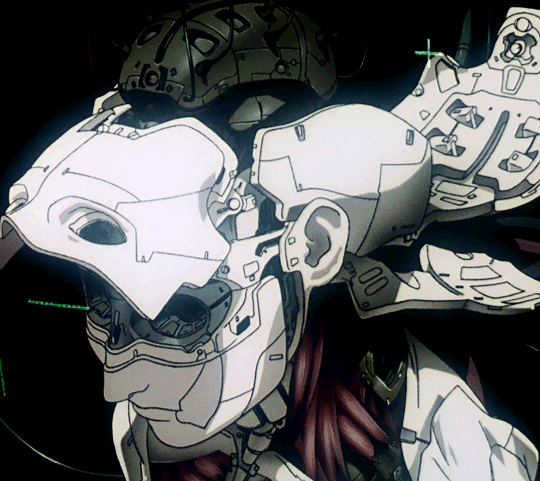
(Originally this was just going to be an excuse to talk about Ghost in the Shell... but I gotta be thorough.)
This was all brought on from this picture from a 1989 fanart magazine...
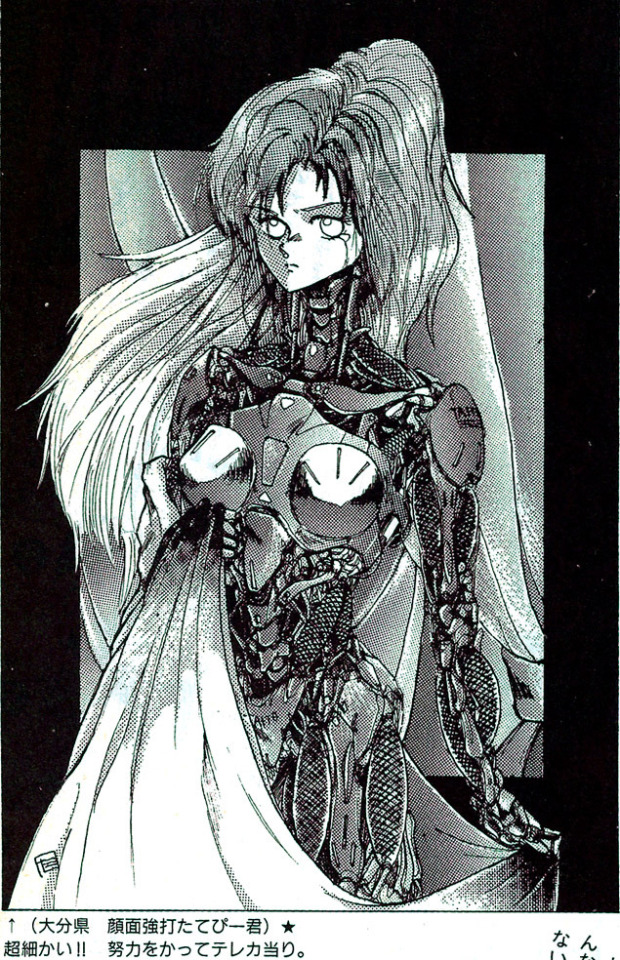
by an artist going by ‘Facepunch Tatebi-kun’ (顔面強打たてびー君, Ganmenkyouda Tatebii-kun). I remarked that it was interesting to see these kinds of ‘robot muscles’ in a picture from 1989, since I thought that kind of design became popular in the 2000s.
On some reflection, I think I gotta revise that opinion! I think ‘robot muscles’ became a thing around the mid 90s in anime; in the West I think it took a bit longer. But you can also see precursors already before that.
So. One thing artists are super into is biomimetic robots. That is, robots whose form (and perhaps function) is similar to animals, especially humans. The word ‘android’ referring to a human-like automaton dates all the way back to the late 19th century, but the modern ‘android, robot, cyborg’ taxonomy apparently became established around the 40s.
There’s two types of humanoid robot that get a lot of play, especially in anime. One is the convincingly humanlike cyborg, which is the same size and shape as a normal human; the other is a what we call in English a ‘mech’, i.e. a big robot you can sit inside.
Of course, if your androids just act like humans all the time, then there’s not much point having them be robots. To really create the frisson of contrast between human and mechanical forms you have to show the mechanism somehow. This could be because the machine isn’t perfectly human-like, and has visibly mechanical joints - take a look at the works of @sukabu89 for very inventive depiction of this theme - or, the android could be damaged or undergo maintenance.
When you attempt to translate biological forms into a more mechanical design language, the traditional way has been to use hard, rigid shapes, since these make the contrast especially clear. In more recent designs, particularly as we started to see real robots with ‘artificial muscles’ such as the ones created by Boston Dynamics, we get another sort of design language to express ‘mechanical parts’, and robots start having more biological forms with exposed plasticy muscles.
So let’s tell the story. We begin at the end of the 70s.
the dawn of mechaguro
For an early example of ‘mechaguro’ (a term I’m applying very anachronistically!), when a robot gets smashed up, we have Alien (1979). This film did a ridiculous amount to define sci-fi design language, and of course the alien itself blends mechanical and biological forms, with its glossy black surface allowing it to seem to melt into the exposed pipes of the spaceship. But let’s focus on the character Ash, a secret android who is broken apart in the second half of the film.

When Ash is torn apart by the alien, his insides consist of weird white plastic beads and a milky fluid that seems analogous to blood. It’s not clear what the function of any of this tech is - it’s intended to be vague and mysterious. The outside is biomimetic but the inside is anything but. He has a kind of artificial skin which resembles a latex mask.
The Terminator films are another major touchpoint for 80s science fiction. Late in the film, Arnie starts taking damage which reveals the Terminator skeleton underneath his fake skin.


The stop-motion Terminator model is basically designed according to the principle of ‘replace human bones and muscles with hard metal bits’. So you have a metal skull, metal clavicles (which are pistons for some reason), metal shoulder blades, hydraulic pistons generally in the places where muscles are. e.g. in the above picture you can see pistons that stand in place of the sternocleidomastoid muscle, and in this picture...

...you can see metal scapulae and piston biceps and triceps and a piston. The shoulder joint by contrast built in a very non-human-like way. Also there’s random tubes everywhere lol.
That’s generally how androids are portrayed in the 80s. The ‘droids’ in Star Wars are similar; C-3PO is an arrangement of metal plates with gaps suggestive of underlying mechanical details and rudimentary joints and pistons.
In Blade Runner, we have the Replicants, humanoid robots - but by the premise of the film, they are essentially indistinguishable from humans. So when the Replicants die, we never really get to see their robo-innards.
and now, anime
OK, that’s the big four Western 80s sci-fi movie series; what of anime? Of course, androids in anime go all the way back to Astro Boy. But most of these early designs don’t really focus on mechanical details all that much. Super robot designs are more like tokusatsu suits than anything. There were certainly instances of impressive mechanical animation in the 70s, with early experts including Kazuhide Tomonaga on Space Battleship Yamato. Then there’s Hayao Miyazaki’s episodes of Lupin III Part 2 which featured proto-Nausicaa flying a prototype of the robots from Castle in the Sky. It would be some years before anyone could come close to matching these!
The original Gundam in ‘79 famously started the ‘real robot’ movement [Animation Night, so let’s take a brief look at how a Gundam fits together.
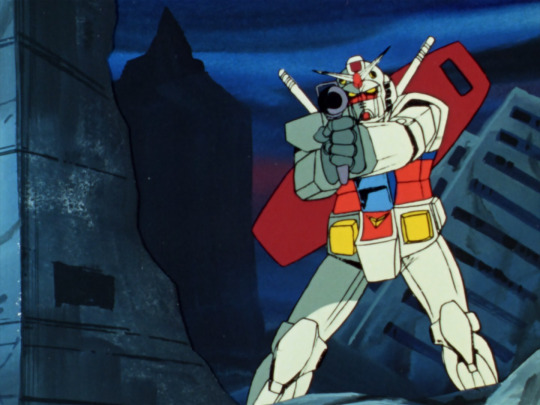
Generally speaking, the way Gundams are drawn in Gundam ‘79 is kind of rough. The methods to animate these rigid mechanical systems in super accurate perspective were just not yet established at the end of the 70s, certainly not on a TV budget. The actual joints on the Gundam are left very vague, but it broadly speaking seems to move like a human in armour.
But the OVA boom was about to begin, and while it would be a while before we saw the heights of Headgear/Production I.G./Gainax, things were going to change a lot. Mechanical design and animation was about to get much more sophisticated very very quickly.
In 1982, we have Super Dimension Fortress Macross, with robots that transformed into fighter jets. Its robots are designed by Kazutaka Miyatake, who cut his teeth doing mechanical design for Space Battleship Yamato and Daicon. The Macross TV series introduced the world to the animation of Ichirō ‘Missile Circus’ Itano. [AN64] A plane with legs... honestly looks kind of goofy, but Itano’s ambition to have a highly mobile 3D camera that could move in ways that would simply be impossible in live action marked a huge step up in how robots are animated. And this would get refined even further in the film Do You Remember Love.
In terms of design, we’re really moving our inspiration from ‘tokusatsu suit’ to ‘military hardware’ here. A Macross suit has to look like something that could transform into a plane, so its silly little arms and legs have to look kind of plane-like. In any case, we are definitely still in a world of hard and rigid robotics.
Dallos (1983-4) dir. Mamoru Oshii is known as the first OVA, if not the first successful OVA [AN115]. It features a variety of mining robots on the surface of the Moon, which are generally less humanoid, taking their design cues from JCBs...

...as well as humanoid robots with fairly clear joint patterns...

...and more humanoid robots too.
The eponymous Dallos, however, is a huge humanoid robot that looks like this...

Here we have a pile of mechanical shapes that vaguely calls to mind a human face. It’s suggestive of motifs we’d see later in works like Akira.
A year later in 1985, Megazone 23 really kicks off the OVA boom in earnest [AN 103]. It also has a robot, in the form of a transforming bike that can become a humanoid piloted mech...

You can see mechanical designs and shading have become considerably more detailed; its motion is a lot more complex as well with a ton of indulgent background animation shots. The actual details of the bike -> robot transformation are rather brushed over. But to sort of sum up the design language: we have organic but hard-edged shapes contrasted by inorganic but round shapes. (These terms ‘organic’ and ‘inorganic’ refer mostly to symmetry and a sense of ‘flow’ in the shape.) There are few right angles as such, but a lot of broadly boxy topology. The shapes are broken up by elaborate specular highlights in complex shapes, a motif of the later Kanada school.
OK, but that’s all variants on ‘rigid robot’ so far - what about the androids? What about the more directly biological designs?
Following the enormous success of Megazone 23 Part I, Toshiki Hirano got the chance to adapt his favourite lesbian cosmic horror hentai manga Fight! Iczer One into a rather more tame OVA which released from 1985-87. In terms of mechanical design, this starts to do some interesting moves towards blending biological and mechanical forms...
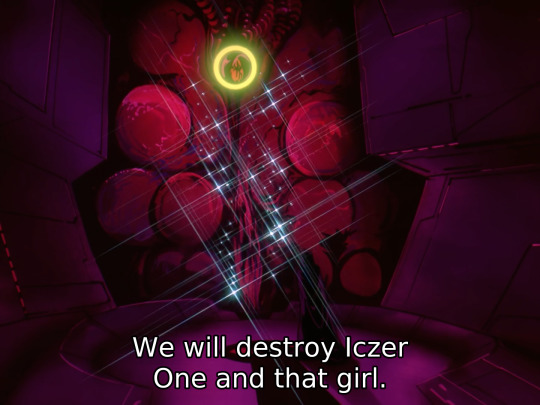
Of course it has a robot in addition to the requisite bishōjo and lightsabers. In contrast to the boxy shapes we’ve seen so far, the robots in Iczer-One have a much more curvy organic sort of design language. Still, there is not a lot of emphasis on the precise details of mechanical articulation outside of select shots. (It is however notable for the first ever Obari punch!)
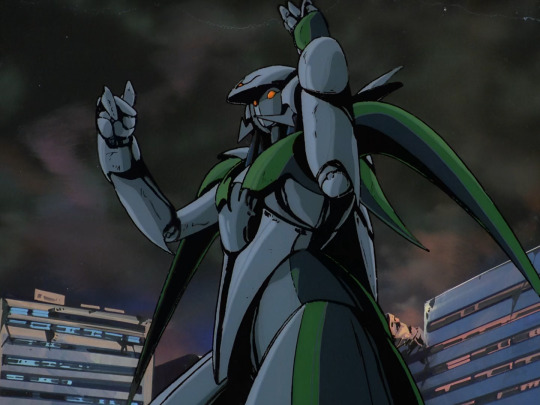
Despite the change in shape language, these are still very clearly animated as metal plates and not yet muscles.
In 1984 we have a very important film (for this narrative, and in general), Nausicaa of the Valley of the Wind, the film that created Studio Ghibli. Here we have the ‘God Warriors’, giant humanoid weapons with the ability to shoot a massive laser out of their mouth. Rather than robots, these are very much biological in nature, having to be grown in a kind of cocoon. In the film version of Nausicaa, an incomplete God Warrior is released, leading to an iconic scene animated by Hideaki Anno in which the God Warrior attempts to blow up the oncoming wave of Ohmu.

The God Warrior’s melting flesh is gorgeously animated, bubbling and sloughing off in great big lumps as the skeleton pokes out from underneath. Throughout, Nausicaa is full of beautiful and impressive animation of both machines (mainly planes) and biological (the giant insects), but the God Warriors, as human-made lifeforms, bring the two together. However, this strand wouldn’t be especially followed up on for a long long time.
Right, but what about Bubblebum Crisis (1987-91)? That is, after all, the iconic 80s robot girl OVA. It’s inspired heavily by Western robot-related films like Terminator and Blade Runner; here we have ‘Boomers’ (never stops being funny) as androids that can appear convincingly human. Like the Terminator, the underlying metal parts can burst out. Here we have a metal frame designed to resemble muscles, and also metal tentacles.
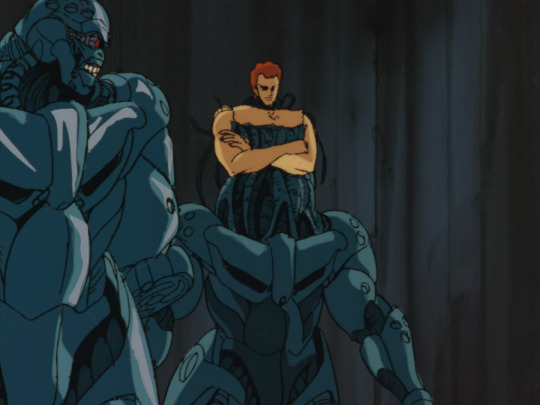

The shapes of these robots are a lot more organic. The robot neck has tubes that sort of resemble the neck muscles, metal plates that resemble pectorals and abs and deltoids and biceps and so on. You’ve even got a direct riff on the Terminator ‘fleshy face falling away to reveal metal skull with glowing red eye’! Under the plates there are clusters of tubes which also heavily resemble muscles. Also you’ve got the classic ‘three small circles’ motif there.
Contrasted against them are the Knight Sabers, who aren’t cyborgs as such but fight in powered exoskeletons which fit the design motifs of robot girls.
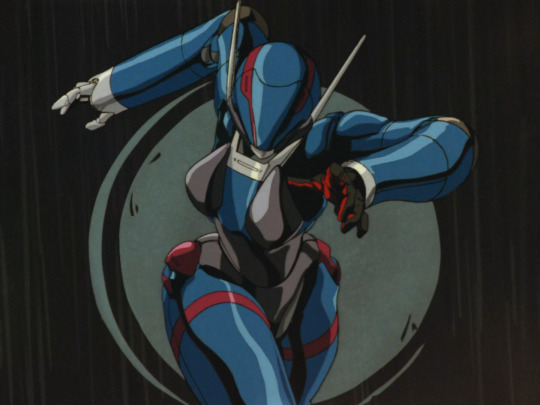
These suits are quite form-fitting, with a rubber under-layer and metal shells on top. There is definitely some attention paid to how they’ll articulate around the joints. One very recognisable 80s motif is the sort of extending spike thingies you can see on her hat there; there’s also the jets that extend out behind the suit. And, you have that multi-layer shiny highlighting of course!
Still, the way the characters move in Bubblegum Crisis is still very squarely Kanada School poses; big movements, lots of held poses accentuated by flashing and line boil, not a lot of concern for conservation of momentum or anything like that.
For a contrasting strand we can look at the rise of the ‘Otomo school’ (if you will) of realism. Around the end of the 80s, a pool of talented animators were gathering around Katsuhiro Otomo. Their most famous work is Akira, but I’m actually going to begin with Robot Carnival (1987), a wonderful anthology of short films from 1987. This features a huge variety of interpretations of the concept of robots.
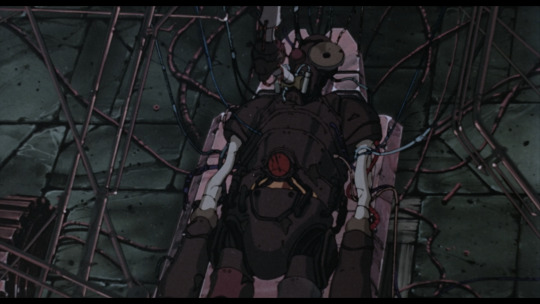
For example, for Kōji Morimoto, later co-founder of Studio 4°C, the robot is a kind of cobbled-together steampunk Frankenstein’s monster. It’s a very cool design with all sorts of asymmetries and exposed parts suggesting its cobbled-together nature. And although all the robot does in this short is stand up and then fall over, a great deal of attention is paid to the little details of its articulation and its movement through space.
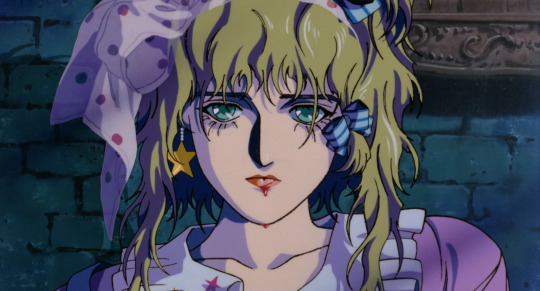
Presence, directed by Yasuomi Umetsu, is notable for its steps in the direction of realism - Umetsu’s characters are hyperdetailed and in some ways over-drawn. The opening shots establish this is a world where lifelike androids are common, when an android gets his head kicked off and stolen by children. Here the robot-as-doll metaphor comes in, something that will be increasingly central in the next decade. The robot girl is essentially a human-sized doll in a room full of other toys. Her creator smashes her to pieces with a wrench; later her ghost visits him as an old man. We see the girl attached to a bunch of wires, but she bleeds like a human.

Cloud by Manabu Ōhashi features another humanoid robot, an Astro Boy-like child recognisable as a robot based on his segmented torso and legs and robotic ear... cones. Here the robot is a standin for human emotions, the boy’s struggles projected onto the constantly changing sky as he walks against the wind.
Strange Tales of Meiji Machine Culture: Westerner’s Invasion by Hiroyuki Kitakubo (later to direct Golden Boy, Roujin Z and Blood: The Last Vampire) is a sendup of mecha shows in which two very goofy looking steampunk robots operated respectively by Japanese and Western crews duke it out, laying waste to the city around them. The Japanese robot is basically a big wooden samurai...

and the Western (more specifically American) robot is, uh
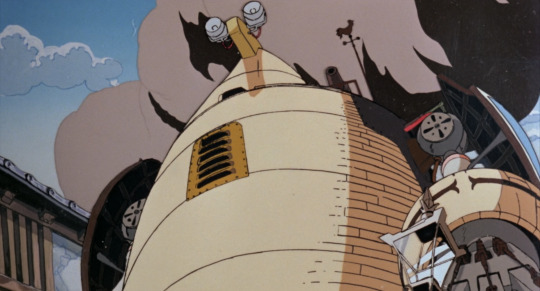
sorta big barrel with little eyes on top? I’m not entirely sure what the deal is with this design!
That’s really not relevant to our story tbh I just think it’s a neat short.
Chicken Man and Red Neck, by Takashi Nakamura, features especially distinctive robot designs. The film is kind of a dream sequence in which a terrified drunk man witnesses the revels of the machines of Tokyo, transformed into robots; the robots are extremely shaped, moving through a world that is pretty much just pistons...
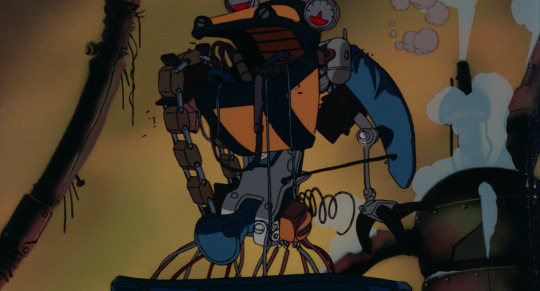
These robots call to mind the dancing demons in Fantasia’s Night On Bald Mountain sequence, or even Bosch.

Otomo’s own segments feature the Robot Carnival itself, a vast mechanical structure built as... well some kind of entertaining spectacle, but which now drives around the post-apocalyptic wasteland dropping robots which explode as bombs. It’s cute.
OK, to wrap up the 80s, we gotta cover Akira (1988) [AN34]! Akira has plenty of impressive mechanical animation of helicopters, hovercraft thingies, satellite lasers and of course the famous bike, but it doesn’t really feature robots as such - but what it does have is a blending of mechanical and biological forms in its climactic sequence where Tetsuo’s psychic powers go out of control. First, wires start to spread like the roots of a plant from his robot arm - less an actual machine and more something he assembled with his psychic powers...
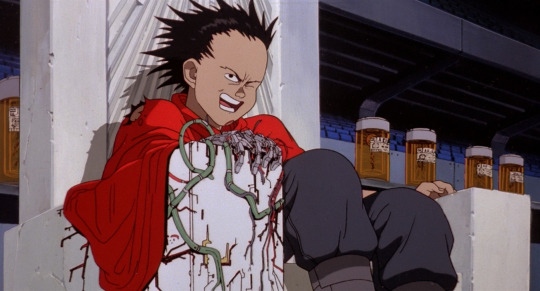
He takes a bullet, and the mechanical wires and muscles start to blend together and spread out like a slime mold...

...which he can extend as essentially a giant tentacle.
When his powers fully go off the rails, he bulges out into big blobs of flesh which have both veins and wires running over them. These burst out of the metallic parts as well.
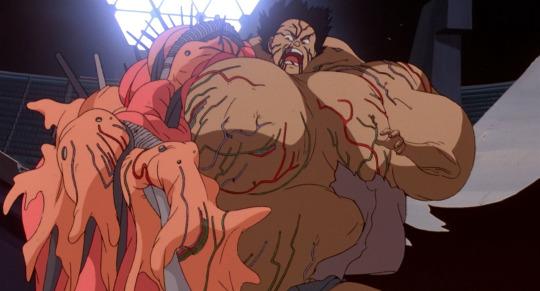
He turns into essentially a giant biomechanical baby.
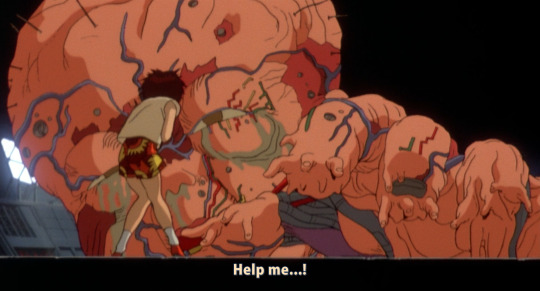
Did Akira invent these images of blending biology and machinery? Probably not, but I’m not really familiar enough with manga of the time to say. What can at least be said is that Otomo’s absurdly meticulous style could really sell it. Otomo was truly a god of perspective and detail; Akira the film was an enormous, prestigious production that threw ludicrous effort and resources towards realising his vision (which doesn’t mean it paid its inbetweeners much more...). A lot of the animators who worked on Akira would go on to be prominent in...
the 1990s
So, the 1990s. If the 80s was dominated by the later Kanada School, the new movement of the 90s, at least as far as film animation goes, was ‘realism’.
But before we get onto that, let’s take a brief look at Gunnm (1990). Known as Battle Angel Alita in the West, this manga by Yukito Kishiro depicts a world in which most people are cyborgs; it was adapted to an OVA by Madhouse in 1993 and became wildly popular overseas. Its protagonist Gally, aka Alita, starts out the story as a wrecked cyborg body like this...
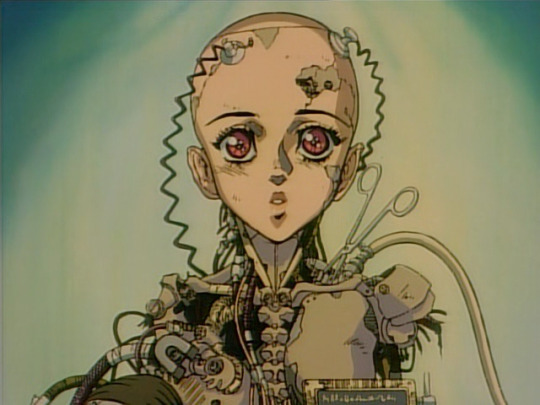
Looking at this design, you can see similar patterns as we have so far. We have metal clavicles, metal sternocleidomastoid muscle, metal pectorals, metal spine. There aren’t robot muscles, per se, but there’s a lot of attention to detail on mimicking biological shapes.
Before long she is rebuilt (twice in the manga, once in the anime). Her new body is like this...

...which is to say a skintight bodysuit in the middle, and metal arms. These arms, although designed in a way that indicates hard surface and with a hinge joint at the elbow, are designed in a way that mimics the flow of muscles in a human arm. By contrast, her sorta-love interest Yugo has a body like this:

which gets mashed to pieces in the finale of the OVA. There’s a striking mechaguro scene in which Gally catches Yugo, but leaves him hanging by a fraying arm, which snaps, leaving him to fall to his death. Compared to later iterations of the ‘robot arm torn apart’ device, this one’s relatively light on detail...
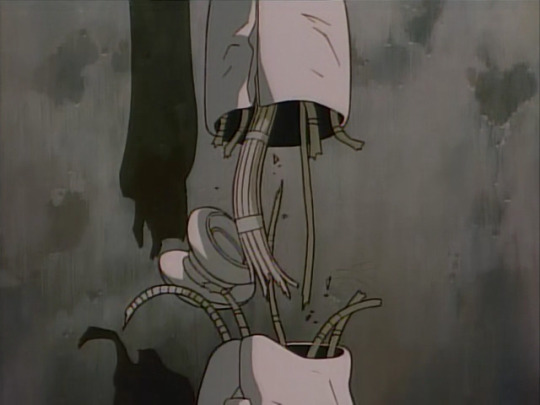
Cyborg bodies in Gunnm are used as a visual indication of character type. Gally has curves but also sleek robo muscles: she’s a Beautiful Fighting Girl, sweet but also extremely powerful. A huge ‘muscular’ cyborg with wide shoulders is likely to be a brute. Yugo here has much more plain, simple shapes with visible bolts, not precision pieces like Gally.
I don’t know how much of this originates with Gunnm. I’m sure the idea of cyborg girls was in the air long before, but this became an influential example on the tail end of the time of the 80s bishōjo. One device that is notable here is the idea of a ‘full body cyborg’, which is only human down to the brain (or perhaps not even that). Body swapping is a major theme in Gunnm, something that would be expanded on before long...
And if that was going out, what was coming in? Let’s look at Patlabor, which traces the evolution of the Headgear artistic collective and IG Tatsunoko into Production I.G.. This is about as down to earth as giant robot stories can get, with robots as just everyday machines used for work and by the cops. But where things really go nuts in animation terms is the opening to Patlabor 2 (1993).
youtube
Here you can see some of the most impressive sequences of mechanical animation ever drawn. We see pilot Noa testing out the robot, and especially notable are the scenes of the hand flexing and of walking. Enormous attention is paid to the articulation of joints. The robot’s hand can swivel 360 degrees, unlike a human; however, like a human, the articulation of the fingers seems to be controlled by hydraulics in the forearm (whereas in humans, the muscles and tendons in the forearm control our fingers). When the robot’s foot steps, it flexes like a real human foot, with believable joints, and a sensible arrangement of pistons to absorb force.
It’s not imitating a human’s muscles, but the attention to the details of the robot’s mechanical design serves precisely to draw our attention to the ways it’s like/unlike a human - the robot’s hand impossible motion immediately contrasted with its pilot shot from the same angle. And the perspective drawing is absolutely impeccable. The robot is made of purely rigid structures, and the way rigid structures articulate is not at all how a human’s joints articulate.
The sequence above was animated by Atsushi Takeuchi. But across the board, the bar was getting pushed for mechanical animation. For example, observe this cut from Mobile Suit Gundam: The 08th MS Team (1996-1999), in which the robot tears off its own arm and beats up another robot. The precision of the way the joints are animated and the way the robots move in space is just completely on another level compared to what Gundam had been doing a couple of decades prior.
Anyway, we’re here to talk about robot muscles, and we’re just a few years out from that now!
The year that robots got muscles, at least as far as anime is concerned, is 1995.
You can probably guess the next part. In 1995, we get Eva and GitS. Let’s start with GitS, to continue the Production I.G./Mamoru Oshii thread. The opening sequence of GitS, animated by - who else could it be? - Hiroyuki Okiura - has to be one of the most iconic segments of video ever drawn. Here’s a merely 720p youtube upload but go and find the place you have GitS stored on your hard drive and watch it in proper quality eh.
youtube
OK, yes, a lot of it is a naked lady floating around, sue me or whatever. But the sense of form. We see early on an appearance of ‘robot muscles’, here closely resembling real muscles...
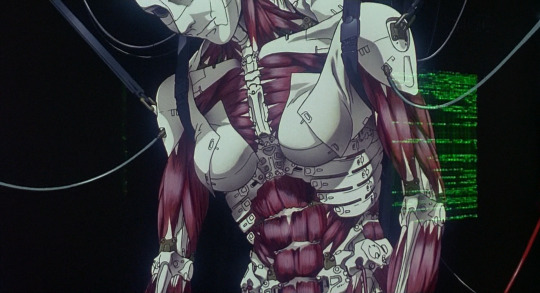
We can see from the way this is drawn that it’s made of a combination of artificial muscles, solid segments, and flexible, fabric-like panels. One of my favourite shots at the beginning shows the solid segments of the skull clicking into place. Here we have a very clear contrast between the angular, hard edges of the mechanical pieces against the organic forms of a human body.
Elsewhere in the film, we see various incredibly cool bits of ‘wouldn’t be fucked up if a body did this‘, like the fingers...
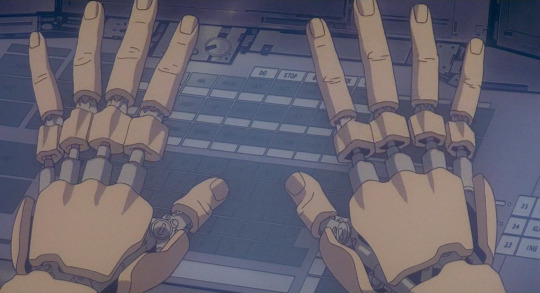
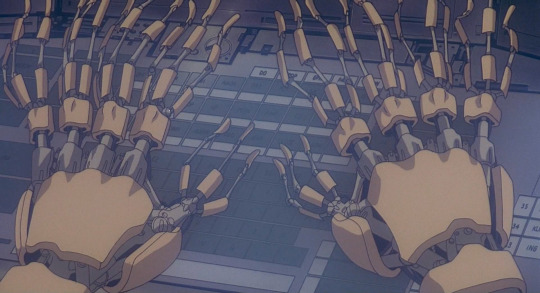
Here, what we expect to be soft biological fingers is contrasted with unexpected rigidity, mechanical joints under a shell.
Also in this scene we encounter a robot body that has been stripped of her arms, legs and hips but is nevertheless still alive...
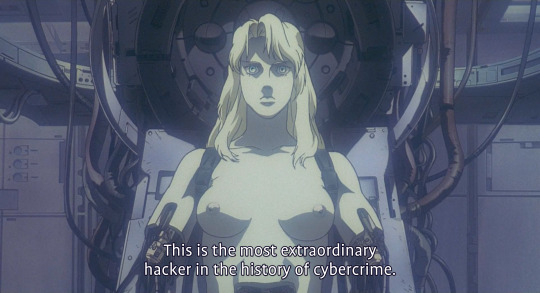

most extraordinary hacker in the history of cybercrime and you have your titties out and yet you still can’t get them to stop misgendering you, smh
For the Terminator, having its body smashed up and continuing to walk was a demonstration of its strength. Here, as would become perhaps an increasing motif, having a robot body is a source of vulnerability: people can do things to you that would kill an ordinary human but you keep going through it. Not surprisingly, ‘robot body maintenance’ is a recurring porn device. (One that GitS deploys in SAC s2).
But of course this all builds up to the all time classics of mechaguro scene at the ending where the Major attempts to tear off the hatch of a spider tank. Muscles ripple individually under the surface of her skin, her arms bulge in exaggerated contraction, and then her arms fully tear apart under the force.
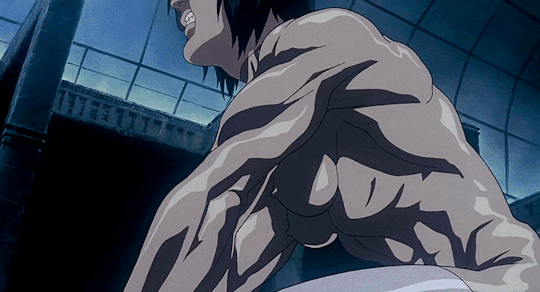
Here, we’re showing her as mechanical not by contrasting rigid forms with biological ones, but by exaggerating the biological ones to the point of doing something extremely unnatural. Human muscles do not generally flex in such an individual way, nor are they strong enough to tear the arm apart, but robot muscles? Yeah, they could do that. This sets up the next scene where the Major lies unnaturally still, but can still exert control through hacking through her union with the Puppet Master.
Robots holding onto something so hard their arms explode has become... if not a recurring image, then at least one that was called back decades later in Violet Evergarden.
The final scene of GitS brings back the image of robot-as-doll, with the Major’s consciousness now uploaded into a black-market robot body that resembles a child in a dress.

This is further expounded on in Oshii’s second GitS movie Innocence (2004), with its Ballade of the Puppets in the soundtrack as Batou and Togusa (and eventually, the Major) are attacked by essentially an army of ball-jointed doll gynoids. The puppets’ movements are extremely unnatural and erratic acrobatics, constantly flipping all over the place; when hit by bullets, panels pop open to reveal the underlying brass skeleton. It’s a very cool image. (The thing that lets the sequence down is the extremely dated CGI and aggressive digital compositing.)
It also has Donna Harraway as a literal cyborg!
Now, the GitS movies didn’t drop fully formed out of nowhere, but draw on the work of Masamune Shirow. The manga has a somewhat different design sensibility than the movie, distinctive and shiny as all Shirow’s art. It is more rounded and organic, less cold.
So, the basic design of a cyberbody originates with Shirow. You can see it on this page (unfortunately from a flipped version, translation Dark Horse):
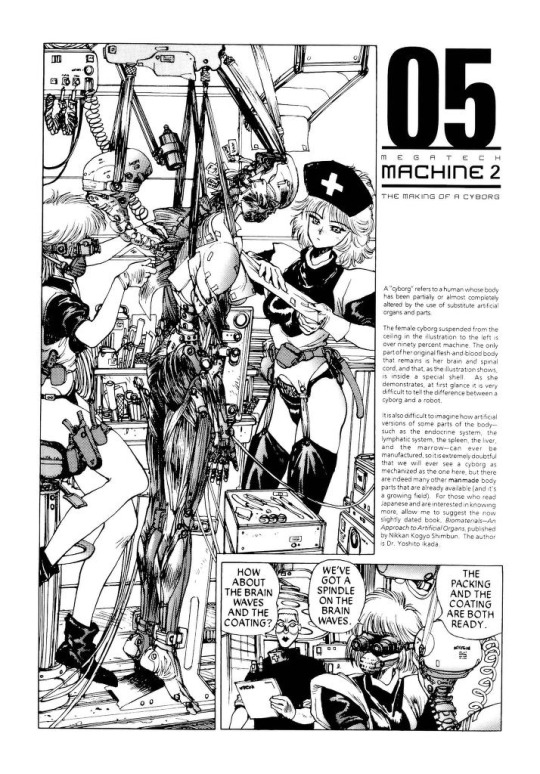
You might be able to determine from how the nurses are dressed that, yeah, the GitS manga is in significant part fetish porn. But really nerdy fetish porn, which is the best kind. This chapter is almost entirely dedicated to explaining how cyborg bodies are constructed in great detail, from the ‘sensory film’ (that’s what’s being applied in the opening to the 1995 film) to the hair implantation.
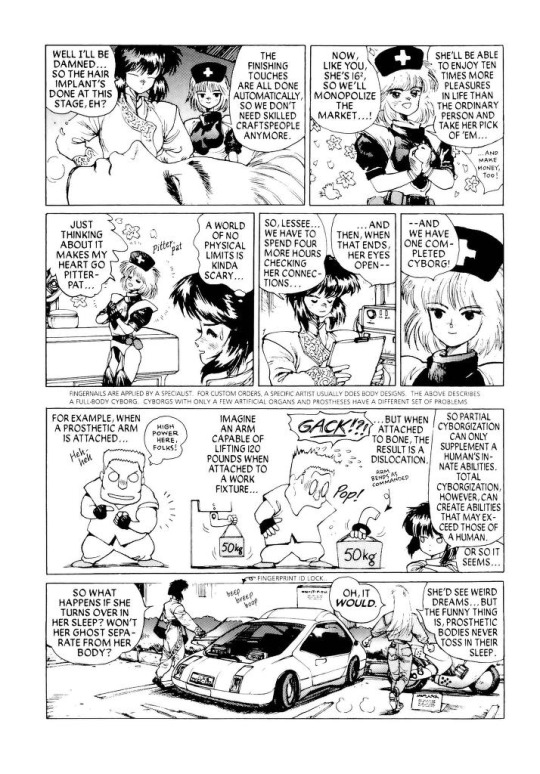
It’s interesting seeing how some of the more out-there designs of the manga, like Chief Aramaki, are transformed into the realist style of Hiroyuki Okiura. It’s Okiura, so it works great of course.
I don’t know if there are manga examples of such detail about cyborg bodies that predate Shirow.
Anyway, that’s just one of the two punches dropped in 1995. The other is Neon Genesis Evangelion. To the pedants: sure, the Evas are not actually robots, but they’re giant cyborgs that play the role of ‘robot’ in the story and they look like robots so I’m counting them.
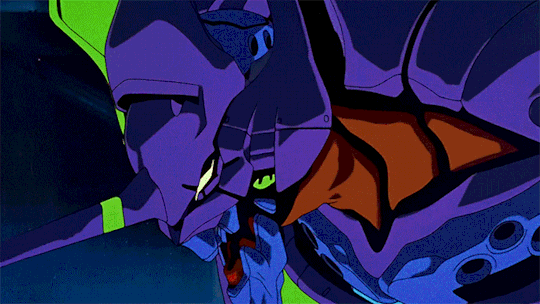
Anyway, the thing about the Evas is they are incredibly lithe. They run, rip and tear and swing heavy objects around in a way that’s both weighty and distinctly biological. Their bodies are extremely flexible compared to prior mechs (look at how much the spines bend in that Iso cut from EoE!), but not without hard, rigid components such as the shoulder towers. Their jaws are bestial but feature mechanical-like components like interlocking hexagonal teeth and jet-like vents. They are in short a fantastic design that blends biological and mechanical features.
The impact of Eva on just about everything can’t be overstated, but as far as robot design, well. There certainly were works that leaned on the precedent set by Eva, as for example RahXephon, which also treats robots as something spiritual, prone to popping into a blob of weird little bubbles just like in Eva.
There’s a great deal missing from this account. I am very focused on anime because I’ve watched a lot more anime than I’ve read manga or played games from this period. So I’m sure there’s major foundational works I’m missing here!
the 2000s
When did the West start to catch up? eh that’s subjective - David Cronenberg was way ahead of the game! - but specifically in the sense of robots with mechanical muscles, I think the major points in the timeline go a bit like this.
In 1999, there’s the Matrix, which leans heavily on anime. This features a similar ‘robot takeover’ premise to Terminator, but here it’s biomimetic robots modelled after squids, with clouds of constantly moving tentacles that sweep behind them. After making a cool half a billion dollars, the Wachowskis decided to pay all their favourite anime directors to make short films. I’m not going to comment on every part of the Animatrix, since most of it isn’t really relevant, but I will point to this horrifying cut by Takeshi Honda in The Second Renaissance in which a robot woman has her clothes torn and then skin bashed off by a mob. The framing, motion, her expression of abject terror, and the ‘reveal’ of her ‘true’ nature, all viscerally call to mind a trans bashing.
On the manga side, a big one to mention is Gantz, a gory nihilistic seinen manga which ran from 2000-2013. The characters in Gantz fight in special latex-like suits which take on the appearance of muscles while engaging superstrength, but can also sustain damage that causes them to drip fluids from ports located at the neck and become fatal to their wearer. Gantz was adapted to anime by Ichirō Itano in 2004, but I haven’t seen it so I can’t comment on any notable animation.
Cyborgs are a favourite subject of games, but in the 2000s, games are really pushing art direction and biopunk stuff is in. Half Life 2 (2004) has its spider-crab like Striders and dropships and so on. Oddworld: Abe’s Oddysee (1997) bases its whole concept around the sheer variety of weird creatures that would inhabit its dystopian factory. And I gotta give a shoutout to Septerra Core (1999) - in case one other person has played that lmao
At some point after 2005, Boston Dynamics became a viral sensation thanks to their robot BigDog. BigDog is just welded steel and hydraulics, but its lifelike hopping movement style definitely brought to mind the idea that the future of robots is going to be in biomimesis.
So, 2007, here comes Crysis to melt your PC! This is an FPS with the not-uncommon premise of being a supersoldier fighting (country America hates) and also aliens, but its gimmick was that you have a special exosuit that wraps around your body with artificial muscles, making you much stronger and manlier or whatever.
youtube
This is indicated by a visualisation that could be right out of a toothpaste ad, where tiny little balls drop into the character’s pores and somehow go straight into the bloodstream which is of course a void full of flying red blood cells. And so on. It sold the game, though! The ad there focuses almost entirely on the suit and not the character wearing it, who is basically an irrelevant soldier man. What it entailed in gameplay terms is that you have a mode switcher so you can have strength or armour or invisibility or whatever. But it’s cool military superscience, you see!
Anyway. Not like my preferred flavour of cyborg is any less stupid I guess x3
In the same year, Bayformers started. These films’ robots are honestly just visual noise, there’s so many moving metal shards going every which way that it’s next to impossible to discern any sort of underlying mechanical principle. A similar ‘overwhelming business’ visual effect would be applied the next year in Iron Man, kicking off the MCU. So mechanical muscles definitely weren’t the only expression of ‘hyper-advanced robot’ in Western visual media in the late 2000s.
I’m going to end my story with two more games: Horizon Zero Dawn and NieR Automata.
Horizon features a world inhabited by a large variety of robot animals, using the peak of AAA rendering techniques. The robots are designed to be biomimetic after both modern animals and prehistoric ones, and feature a combination of hard surfaces and softer biological muscles. For example, a robot horse:
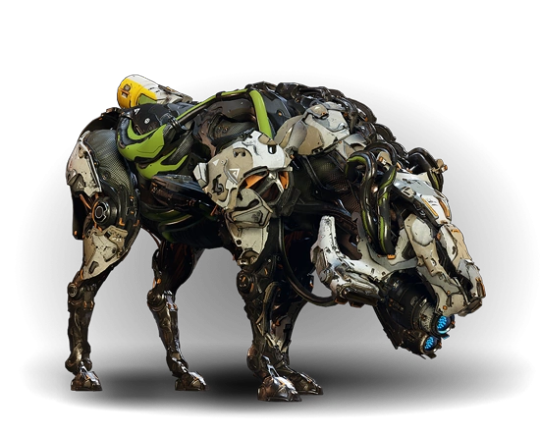
The discipline of making designs like these now has a name: it’s called ‘hard surface modelling’ and it involves boolean operations and bevels and other techniques designed to create a balance of hard edges on a surface against the smoother parts. The design language of Horizon says that the hard plates are white, the soft parts are very dark and may be patterned like a cloth texture, and there can be small colour accents here and there.
I think you can definitely see the influence of Boston Dynamics’s robots (and recent military tech in general) in these designs, iterated on through a decade and a half of increasingly intra-referential concept art. They are visually very busy designs, but there are a couple of recognisable features that draw attention by being inorganic, such as the cylindrical fuel tank at the back. Vitally, the silhouette is very readable.

This robot T. rex for comparison serves as a world boss monster, and you can see it’s got a bunch of military looking attachments that look like radars and missile launchers and so on. As real tech evolved, so too did our idea of what a scary robot ought to look like.
So, that’s where this kind of design pattern has gone in mainstream games.
Now to finish, a brief comment on NieR Automata. Its designs draw hard on those of Ghost in the Shell. Visually it draws a strong contrast between the Machine Lifeforms, who have inorganic shapes (spheres and cylinders) and very visible and plausible mechanical joints, and the doll-like androids, who might as well be human (although A2 provides some contrast in an android who is damaged enough for the underlying materials to show through). The mechanical nature of the androids is communicated by the acrobatic way they move and the interface elements, and dead androids you find in the field - and later when they start losing arms and stuff, it’s a whole thing. But just like humans in Yoko Taro Games, they’re capable of dying in a puddle of blood.
(I guess if you take one thing from this post it’s that if you’re a robot, don’t expect to keep your arms.)
Robot muscles gives you a chance to give both the ‘anatomy porn’ of drawing something very precisely right, with the added bonus of giving you a reason to draw the muscles écorché, and the chance to make it weird and defamiliarised by splitting it with mechanical elements. In short... they look cool!
In this whole post I’ve basically not touched at all on illustration. I can point to a variety of illustrations of robot girls, but in terms of periodising them, I just don’t think I know enough. Though it’s safe to say that cyborg bodies in various states of construction or disrepair are now a mainstream of concept art - and that Ghost in the Shell is usually cited as an influence. I don’t know if robot muscles ever truly became the mainstream way to depict a robot, but it does feel like they’re increasingly common.
One artist I will briefly mention (besides sukabu), mostly bc I think they’re neat, is Haruyo Megurimu, who draws these very intricate designs of ‘necrotech’ which is sort of very biological robots extending out of human bodies - limbs extended on long spindly insectoid strands, jaws splitting open, that kinda thing. Can’t say who influenced them or anything but it’s a compelling extension of the idea into a particular corner of aesthetic space.
And that’s all I’ve got I think. There’s definitely big gaps like. More recent sci-movies. Western comics. Nevertheless, that’s an arc.
If you’ve read this far: thank you for indulging my autism.
787 notes
·
View notes
Text
Hummingbird Hawk Moths: as a result of their hummingbird-like behavior and appearance, these moths are often mistaken for actual hummingbirds

The Eurasian hummingbird hawk moth: Macroglossum stellatarum
Like an actual hummingbird, the hummingbird hawk moth uses a flight maneuver called "swing-hovering" (rapidly swinging from side-to-side while hovering in mid-air), has a wing-speed of up to 85 beats-per-second, produces a humming noise when flying, and feeds on the nectar from flowers; the hairs on its body even resemble the tail-feathers and wings of a hummingbird.
These moths are also able to maintain a stable position in mid-air by relying on the same flight patterns that are found among hummingbirds -- the moth rapidly rotates its wings in a "figure-8" motion, generating lift on both the forward and backward strokes, which effectively allows the moth to hover in place. The flight maneuvers (and other adaptations) of the Eurasian hummingbird hawk moth are so similar to the characteristic traits found in hummingbirds that this little moth is often mistaken for a real hummingbird, despite the fact that it is found exclusively in habitats that do not contain any wild/native hummingbirds. Though this species can be found in various ecosystems throughout the British Isles, mainland Europe, Central Eurasia, and even some parts of North Africa, there are no actual hummingbirds in any of these regions, as wild hummingbirds are found only in the Americas.
These moths (M. stellatarum) have a wing-speed of up to 85 beats-per-second. For comparison, the amethyst woodstar hummingbird, which is one of the smallest and fastest hummingbirds in the world, has a similar wing-speed of up to 80 beats-per-second.

While most other moths are nocturnal, the hummingbird hawk moth is active only during the day. It uses a specialized proboscis to feed on the nectar from various flowers, including honeysuckle, jasmine, tulip, red valerian, lilac, and phlox. This species also differs from other moths due to its lack of auditory organs, meaning that it has no sense of hearing. Among most moths, auditory organs have evolved as a defense mechanism to detect the ultra-sonic chirps that are emitted by predatory bats at night, but because the hummingbird hawk moth is only active during the day, when bats are largely inactive, that particular defense mechanism was not developed.
Experts generally believe that the similarities shared by hummingbirds and hummingbird hawk moths actually arose through convergent evolution; this means that the hummingbirds and the moths both experienced a similar set of needs, pressures, and circumstances within their respective environments, and they simply developed similar adaptations in response to those circumstances. Their uncanny resemblance therefore does not qualify as a form of animal mimicry -- the moths may look and act a lot like hummingbirds, but the resemblance is viewed as a product of incidental factors, and it is unlikely that those similarities were developed for the purpose of providing camouflage.
This is not the only type of moth that is commonly referred to as a "hummingbird moth." The genus Macroglossum contains several moth species that have hummingbird-like characteristics, and the term "hummingbird moth" can be applied to many of them; there are also at least five "hummingbird moths" in the genus Hemaris, although they belong to a separate clade and their resemblance to hummingbirds is somewhat less convincing. They include H. thysbe (also known as the hummingbird clearwing moth), H. diffinis (the snowberry clearwing moth), H. thetis (the Rocky Mountain clearwing moth), H. aethra (the Diervilla clearwing moth), and H. gracilis (the slender clearwing moth), all of which are found in North America.

Moths of the genus Hemaris: these moths may sometimes be identified as "hummingbird moths;" the genus Hemaris also contains a variety of moths that are popularly referred to as "bee hawk moths" or "bee moths" because they bear a resemblance to bumble-bees.
The Eurasian hummingbird hawk moth is not closely related to any of the "hummingbird moths" from the genus Hemaris, however, as it belongs to a completely different genus and occupies a separate habitat on the other side of the Atlantic. Still, it's interesting to note the presence of similar hummingbird-like traits within these different genuses.
Sources & Addition Info:
PBS Nature: Featured Creature, the Hummingbird Hawk Moth
The Wildlife Trusts: Hummingbird Hawk Moth
Royal Society for the Protection of Birds: Article about Hummingbird Hawk Moths
Journal of Comparative Physiology: Fuelling on the Wing: the sensory ecology of hawk moth foraging
Country Life: The Confusingly Enormous Hummingbird Hawk Moth that Looks Set to Become a Regular Fixture in British Gardens
#moths#cute moth#tw bugs#hummingbird#hummingbird hawk moth#insect#entomology#evolution#science#nature#lepidoptera#biology#I spend way too much time reading about moths#but they are just wildly underrated
620 notes
·
View notes
Note
What’s the case for an upper and lower chamber?
In my opinion, none.
The historical situation is that the upper chamber had more power and the lower was a sop to the common folk and petty nobility: this is why the House of Commons was formed (originally from knights of the shire and the representatives of cities that had been granted special rights by the Crown), and only later, after a very long process of constitutional evolution in Britain, did the Lords transform into a consultative body that was adjunct to the Commons, where the real power lay. For a while, even after you started to have something that looked like modern government in Britain, you still frequently had PMs drawn from the Lords--and still could, in theory, except that the convention is they come from the Commons.
In the U.S. example, the goal was simply to split the difference between a popular chamber (the House) and a chamber representing state governments (the Senate, whose members could be chosen by any method provided for under state law, but originally were usually chosen by state legislatures). This is because the people who drafted the U.S. constitution hated and were suspicious of popular democracy, because they were rich landowners and slaveholders whose positions were untenable in the long run if everyone in the country could vote and was equally represented.
Obviously they didn't put it like that--they spoke of the hotheaded hoi polloi, the changeable will of the people--but they were massive Romeaboos, and all the populist leaders who whittled away at the Roman republic managed to do so because they were willing to centralize power, to take it away from the baronial elite of the Republic, and to use that power in service of people further down the org chart. In service of themselves too, of course--these were not altruists--but it was the particularly Roman instantiation of the crown-vs-barons struggle, where the common folk usually side with the Crown, because the barons are bastards who abuse them directly.
(Very many "tyrants" in history were "tyrants" only in that they gave a raw deal to the barons in their particular social order, and very many events which we now describe as movements toward a more equitable distribution of power were in fact a very shitty deal for the majority of the population--the peasants--because it gave the barons even more license to abuse their serfs.)
And the American founders knew all this, and they were all barons, and they didn't like the idea of a federal government that was too effective, so they sprinkled it with veto points and also totally failed to anticipate the rise of modern political parties. (Which weren't exactly what they had in mind when they warned against factionalism--that was more about sectional interests. But still, they did totally fail to anticipate how this system would work as party politics developed.)
In a system of democratic government like the U.S. has now, where it is widely acknowledged the rule should be "one adult citizen never convicted of a felony who can get the day off work to stand in line and has a photo ID = one vote" the U.S. Senate is an inexcusable anachronism. Indeed, the Supreme Court has ruled that state senates modeled on the exact same principle as the U.S. senate (say, one county one senator, as the constitution of my home state Tennessee has it) are unconstitutional, because they violate the equal protection clause.
More recently, many countries have approached the idea of an upper chamber as a sort of "chamber of experts" meant to review and advise on legislation. This kind of makes sense in theory, I guess, but if voters want subject-matter experts to make policy, they can vote them in; in practice, any system of appointment or ex officio qualification is going to select for political lackeys without democratic mandates, and it's also just a bad idea to have people with significant power over the legislative process who do not have democratic accountability. The problem of creating legislation is never that we don't have enough smart people willing to offer their opinions; the problem is brokering functional compromises between interest groups and resolving incentives that push the process toward dysfunctional outcomes, which isn't really something you can fix just by fiddling with the composition of your upper house.
So in most modern parliamentary democracies, upper houses are reduced in power. Either they can't veto bills permanently (Lords), they can't originate money bills (Lords again), they only have input on certain matters (German Bundesrat), they're full of government appointees to ensure the government always has a majority in them (Irish Seanad), or the lower house can overrule them on most matters (Japanese House of Councillors). And the reason why is obvious: if your democratic mandate comes from the lower house, if that's where your government is being formed in a parliamentary system, if the whole principle of government is meant to be collective self-rule by the body of citizens, an upper house that is a check on that power is either definitionally redundant or a brake on democracy.
There are ways to ensure that a lower house is both representative and does not devolve into factional chaos. Proportional representation, four-year terms, constructive motions of no confidence (again, parliamentary systems only), etc. Plenty of countries and subnational entities have unicameral legislatures and are perfectly stable: Sweden, Norway, the Baltics, Portugal, Mongolia, South Korea, Peru [ok bad example nvm], all the states of Germany, all the provinces of Canada, most of the provinces of Argentina, Queensland, the vast majority of the states of India, and the three devolved legislatures in the United Kingdom.
Therefore in my opinion there is no good democratic case for an upper house. And all the undemocratic reasons why you'd want one are bad. Too much democracy is, in fact, a very rare problem for systems of government to have!
113 notes
·
View notes
Text
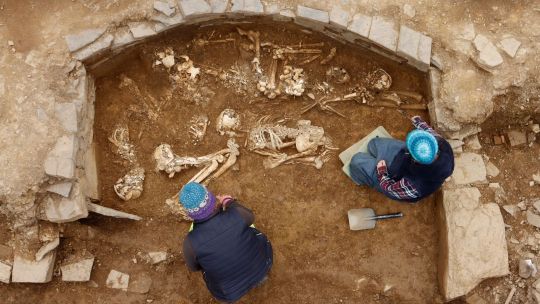
'Incredibly Rare' 5,000-Year-Old Tomb Discovered in Orkney, Scotland
A three-week excavation took place at the Neolithic site at Holm.
Archaeologists have discovered the ruins of an "incredibly rare" 5,000-year-old tomb in Orkney.
Fourteen articulated skeletons of men, women and children were unearthed at the Neolithic site at Holm on the mainland.
Experts from National Museums Scotland (NMS) and Cardiff University also uncovered additional human bones following a search for the tomb's precise location.
Volunteers and students from the University of Central Lancashire made other discoveries during the three-week excavation, including finding further remains, pottery, stone tools and a bone pin.
NMS said the Neolithic site had been buried beneath a pasture field after it had been largely destroyed without record in the late 18th or early 19th century to supply building stone for a nearby farmhouse.
In 1896, the farmer's son found eight skeletons at the site alongside traces of walling, a stone macehead and ball.

The Orcadian's report on the discovery featured local antiquary James Walls Cursiter, who speculated that the site was a ruined tomb - which prompted the location of the 2023 search.
The excavation was led by Dr Hugo Anderson-Whymark, of NMS, and Professor Vicki Cummings, of Cardiff University.
It targeted anomalies recorded via a geophysical survey undertaken in 2021.
It revealed traces of a cairn more than 15m in diameter, which contained a stone structure accessed through a 7m-long passage.
The archaeologists said a stone chamber lay at the centre of the cairn, and this was surrounded by six smaller side cells that once had corbelled stone roofs.
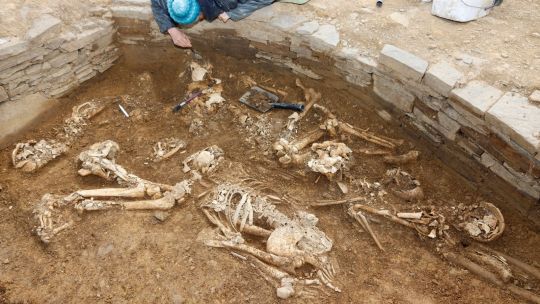
These features allow the tomb to be classed as a "Maes Howe-type" passage grave.
Only 12 tombs of this type are known in Orkney - including Maes Howe, Cuween and Quoyness - and are considered the "pinnacle of Neolithic engineering" in northern Britain.
Dr Anderson-Whymark said: "Orkney is exceptionally rich in archaeology, but we never expected to find a tomb of this size in a such a small-scale excavation.
"It's incredible to think this once impressive monument was nearly lost without record, but fortunately just enough stonework has survived for us to be able understand the size, form and construction of this tomb."


Professor Cummings added: "The preservation of so many human remains in one part of the monument is amazing, especially since the stone has been mostly robbed for building material.
"It is incredibly rare to find these tomb deposits, even in well-preserved chambered tombs, and these remains will enable new insights into all aspects of these peoples' lives."
By Jenness Mitchell.

#'Incredibly Rare' 5000-Year-Old Tomb Discovered in Orkney Scotland#ancient tomb#ancient grave#ancient artifacts#archeology#archeolgst#history#history news#ancient history#ancient culture#ancient civilizations
195 notes
·
View notes
Text
Tuesday, August 1.
Architecture.
Firmitas, utilitas, venustas.
These are the central pillars of, well, #architecture, according to Roman architect Vitruvius in the early 1st century AD. These are the principles that should guide the mind, eye, and, ultimately, the hand of the architect. The original translation would convey this as firmness, commodity, and delight. Another translation into more contemporary English would be firstly, durability: that a building should stand up robustly and remain in good condition; secondly, utility: it should be suitable for the purposes for which it is used; and finally, beauty: that it should be aesthetically pleasing.
There are many definitions, understandings, and theories of what makes architecture, or what separates it from construction. What is easily understood is that architecture is a testament to our ability to create forms and landscapes as compelling as those provided by the natural world—and that you very rarely feel as present as when you walk the streets of a new city, and marvel at the shapes, forms, and styles that surround you.
But why not leave it to the experts? Le Corbusier, a renowned 20th-century architect, once wrote: "You employ stone, wood, and concrete, and with these materials you build houses and palaces: that is construction. Ingenuity is at work. But suddenly you touch my heart, you do me good. I am happy and I say: This is beautiful. That is Architecture".
#today on tumblr#artists on tumblr#arhitecture#architecture#architettura#landscape architect#conservation architects#art deco architecture#gothic#brutalist#art#artists#land acquisition architect#interior design
391 notes
·
View notes
Text
STOP THE NZ GOVERNMENT'S WAR ON NATURE
Just when you thought they'd hit rock bottom, the National/Act/NZ First coalition government keeps digging. The fast-track approvals bill was released last month and forms the latest part of the government's war on nature. This would allow major infrastructure and industry projects such as mining, road construction and large-scale aquaculture to be fast-tracked if they are considered to be regionally or nationally significant. While I completely agree that the current Resource Management Act consenting process is not fit for purpose, its regulations are stringent for a reason - to protect our climate, our indigenous biodiversity and our whenua. We need development in New Zealand to be sustainable, and to focus more on nature-based solutions. This legislation is taking our country in the wrong direction. It's not the fast-track it's the wrong track!
Lack of consideration for environmental damage: This project requires the economic benefits of a project to be considered above all else. In the midst of intersecting climate and biodiversity crises, we should prioritize protecting the habitats we have left and supporting efforts to restore ecosystems.
Lack of regulation against negative human health impacts: Even if you're not a nature lover like me, we can probably all agree that exposure to carcinogenic chemicals and other toxins, dangerous pollution in outdoor recreation areas such as rivers and beaches, and air pollution are things that no New Zealander wants. This bill does not exclude projects and activities that will have a negative impact on human health.
Lack of transparency: There are already many projects earmarked for fast tracking under Schedule 2A of this bill, but this list has not been published, meaning a fast-tracked project could be coming to a place near you soon, and you'd have no idea until after the bill has passed. Details about the process for project selection and review are scarce.
Undemocratic: Rather than going through the full submission process, projects are sent straight to a panel to be reviewed. This means that local people and conservation groups won't get to have their say on projects that will directly affect them and the work they do. This is a blatant overreach of central government into local affairs, from a government who criticized Three Waters because they thought it took too much decision-making ability away from the regions.
Risks of corruption and conflict of interest: The expert panels do not get the final say of which projects are approved; they can be overridden by any of these three ministers: Simeon Brown (Minister for Energy and Transport), Chris Bishop (Minister for Infrastructure) and Shane Jones (Minister for Oceans & Fisheries, Resources and Regional Development). Having one person make these calls presents a much greater risk of conflicts of interest occurring (and let's be honest, this is quite a risk).
Submissions on this bill are open until April 19th, and there are templates online you can use to make a submission if you're pressed for time. My favourites are from the Forest & Bird (the organization I volunteer with) and the Environmental Defence Society (linked below). You can also write to your local MP and let them know you DO NOT support this bill.
More information and submission templates:
STOP the War on Nature | Forest and Bird
Make a submission on the Fast-track Approvals Bill using EDS’s template | EDS
51 notes
·
View notes
Note
This is probably going to be my last big ask for a while, so let’s make it count. What I really wanted to talk about is Yuu and disease. It’s probably just me, but while the cute caretaker sick fics are nice and all, I just sit there worrying about Yuu’s heath.
As a completely different world, realistically Twisted Wonderland would not have the same diseases as Earth. Poor Yuu must have gone down like a sack of bricks the first time they got sick, at the very least. I’m not exactly knowledgeable about the medical field or anything, but even babies have some kind of an immune system thanks to receiving temporary antibodies from their mothers that hold them over until they can receive vaccines. Yuu doesn’t have that.
To make this worse, Ramshackle is well… ramshackle. Before it got rebuilt I guarantee that building was having untold issues even after being cleaned up. I mean, I highly doubt Ramshackle is temperature regulated via magic like the rest of the school due to it being abandoned. Yuu spent all of fall and part of winter in a run-down dorm. And ‘part of winter’ thing is me being generous given the iffy timeline of the game’s story.
I know it’s a running joke to dunk on Crowley for being an irresponsible guardian, but this is a terrifying level of oversight if none of the adults considered this about Yuu’s medical vulnerability. Another strike in favor of Yuu just running away.
- 🦐
I am so sorry I took forever to get around to this my dear Shrimp, I'm also not a medical expert so I had to really think about this. Disease in worlds with magic tends to be an underdeveloped part of most settings world building.
... also if you saw me post this before I was done cooking no you didn't ¬o( ̄- ̄メ)
I want to start off by saying that I disagree about Ramshackle not being temperature regulated... sort of. Ramshackle is more or less a Victorian era mansion, so if we assume that it has the same general architecture then while it does lack a central heating system, it is more or less capable of maintaining heat in individual rooms. If you look at the in game artwork for the dorm, there are visible fireplaces in both of the main rooms where we spend time, the Lounge:
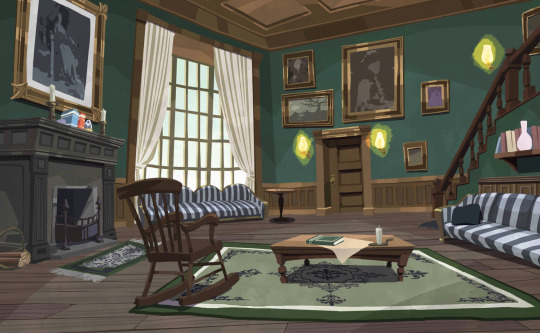
And our room:
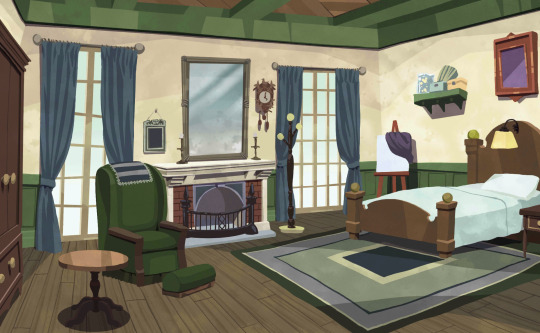
As long as that fire is kept going, those individual rooms will have heat, and while that falls under the purview of the fire faeries that work for the school I can see Yuu being able to take care of themselves enough to keep their dorm warm. There is even a stack of wood next to the lounge fireplace, so we can assume they can get a fire going to heat the place. The real issues (from Grim's complaints) seems to be a lack of hot water and holes in the roof, both of which they would have had to live through most of winter with that could have caused things like a bad cold or pneumonia before we even get to potential magical diseases.
When it comes to magical diseases and vaccines... my understanding of disease is that a lot of them start in animal populations before they make their way into humans. So while Twisted Wonderland is a different world, the animals are more or less the same so I can see them having the same general diseases as our world... but as people use magic to treat the disease that introduces the potential exists for diseases to evolve to combat the magic treatments. I think it's those treatments Yuu would be more vulnerable to than the twst variants of the diseases they have back home; there's a whole host of new potential allergens in the potential cures they haven't been tested for and there is no guarantee using magic on Yuu won't hurt them.
If there are magic based diseases that come from the monster population, then Yuu would absolutely need vaccines for those but I could also see things like that as not being thought of as illnesses but rather a form of a curse, and therefore something that requires a different type of treatment. And I agree this does seem like a terrible level of negligence and oversight from the adults at NRC... but I can also see why it happens. Yuu shows no outward sign of being anything other than a normal, magicless human so I can see them sort of just assuming Yuu would function the same as anyone else and then go from there.
What really got me thinking in this ask was the potential for Yuu to need something like an inhaler, or an ssri, or hell even my iron supplements and how that would get handled. Especially ssris, I have a bit of experience with getting medicated and it can take forever to get on a combo that gives you your life back as opposed to fucking things up further. Getting snapped into another world without those meds and having to go through the process again in a world with a different concept of chemistry would suck so much. Poor neurodivergent Yuu's, as if life didn't suck enough already.
#<3 asks#twisted wonderland x reader#twst x reader#twst yuu#shrimp annon#talking about this made me think about how medical drama is an underdeveloped isekai genre#and i will not be fixing that#i have too many other ideas
87 notes
·
View notes
Text
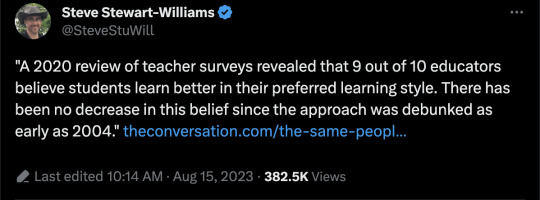
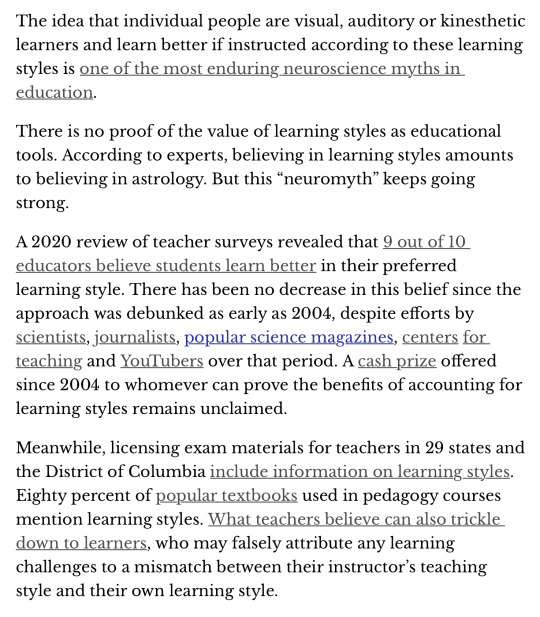
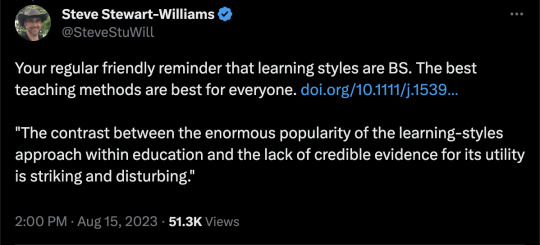
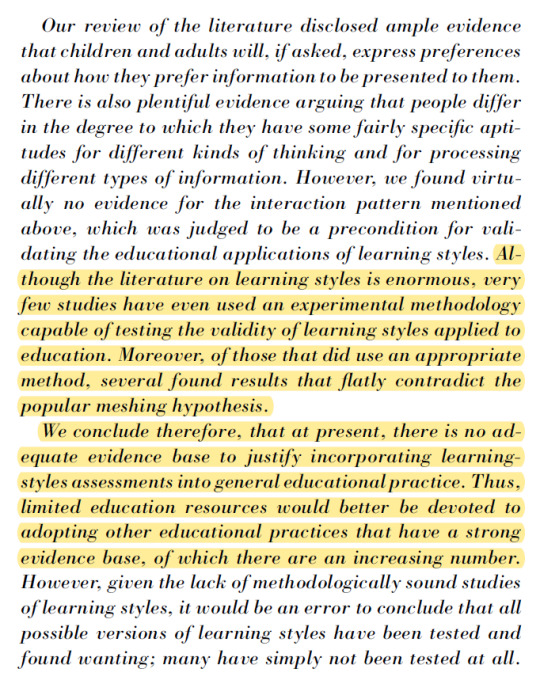
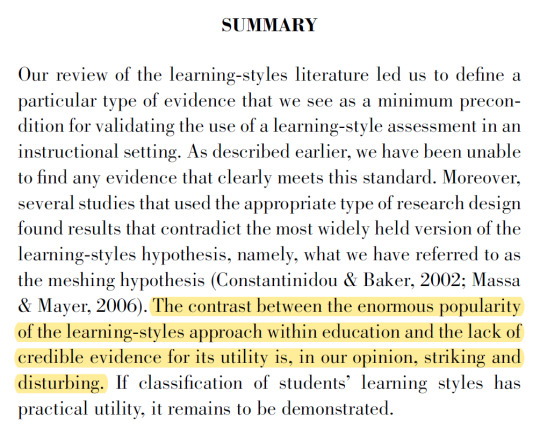

Abstract
Many teachers and researchers, among others, continue to believe, despite the lack of evidence, that learning will be more effective if educators match their teaching approaches to students’ alleged learning styles. Scholars have called for more research on why the belief in learning styles is so appealing. This conceptual paper suggests four moral intuitions or sensibilities that underlie the appeal: (1) the desire for rational control, (2) our sense of justice, (3) the feeling that everyone is unique, and (4) reverence for the natural. Speaking to these intuitions could strengthen efforts to debunk the myth of learning styles in teacher education.
[..]
Experts aren’t sure how the concept spread, but it might have had something to do with the self-esteem movement of the late ‘80s and early ‘90s. Everyone was special—so everyone must have a special learning style, too. Teachers told students about it in grade school. “Teachers like to think that they can reach every student, even struggling students, just by tailoring their instruction to match each student’s preferred learning format,” said Central Michigan University’s Abby Knoll, a PhD student who has studied learning styles. (Students, meanwhile, like to blame their scholastic failures on their teacher’s failure to align their teaching style with their learning style.)
Either way, “by the time we get students at college,” said the Indiana University professor Polly Husmann, “they’ve already been told ‘You’re a visual learner.’” Or aural, or what have you.
The thing is, they’re not. Or at least, a lot of evidence suggests that people aren’t really one certain kind of learner or another. In a study published last month in the journal Anatomical Sciences Education, Husmann and her colleagues had hundreds of students take the Vark questionnaire to determine what kind of learner they supposedly were. The survey then gave them some study strategies that seem like they would correlate with that learning style. Husmann found that not only did students not study in ways that seemed to reflect their learning style, those who did tailor their studying to suit their style didn’t do any better on their tests.
Husmann thinks the students had fallen into certain study habits, which, once formed, were too hard to break. Students seemed to be interested in their learning styles, but not enough to actually change their studying behavior based on them. And even if they had, it wouldn’t have mattered.
“I think as a purely reflective exercise, just to get you thinking about your study habits, [Vark] might have a benefit,” Husmann said. “But the way we’ve been categorizing these learning styles doesn’t seem to hold up.”
Another study published last year in the British Journal of Psychology found that students who preferred learning visually thought they would remember pictures better, and those who preferred learning verbally thought they’d remember words better. But those preferences had no correlation to which they actually remembered better later on—words or pictures. Essentially, all the “learning style” meant, in this case, was that the subjects liked words or pictures better, not that words or pictures worked better for their memories.
In other words, “there’s evidence that people do try to treat tasks in accordance with what they believe to be their learning style, but it doesn’t help them,” says Daniel Willingham, a psychologist at the University of Virginia. In 2015, he reviewed the literature on learning styles and concluded that “learning styles theories have not panned out.”
That same year, a Journal of Educational Psychology paper found no relationship between the study subjects’ learning-style preference (visual or auditory) and their performance on reading- or listening-comprehension tests. Instead, the visual learners performed best on all kinds of tests. Therefore, the authors concluded, teachers should stop trying to gear some lessons toward “auditory learners.” “Educators may actually be doing a disservice to auditory learners by continually accommodating their auditory learning style,” they wrote, “rather than focusing on strengthening their visual word skills.”
In our conversation, Willingham brought up another study, published in 2009, in which people who said they liked to think visually or verbally really did try to think that way: Self-proclaimed visualizers tried to create an image, and self-proclaimed verbalizers tried to form words. But, there was a rub, he said: “If you’re a visualizer and I give you pictures, you don’t remember pictures any better than anyone who says they’re verbalizer.”
This doesn’t mean everyone is equally good at every skill, of course. Really, Willingham says, people have different abilities, not styles. Some people read better than others; some people hear worse than others. But most of the tasks we encounter are only really suited to one type of learning. You can’t visualize a perfect French accent, for example.
==
Considering the sources of teacher training, Ed Schools, are extremely highly ideological, the perpetuation of this "neuromyth" is probably not an accident or misunderstanding.
These are the schools that have attached quasi-religious overtones to their preferred, but ineffective, process of teaching kids to read, and have been denying evidence-based methods for decades.
#learning styles#pseudoscience#education#corruption of education#neuroscience#myths#science#VARK#visual learner#auditory learner#reading learner#kinesthetic learner#junk science#religion is a mental illness
78 notes
·
View notes
Note
I’m infinitely fascinated by the falmer in Halfway to the Sky, I really want to know more about your ideas for their culture etc
Thank you so much anon! I kind of had to sit with this one, since I don't really have a lot of my Falmer headcanons written out or in one place as it stands. Before writing their introduction in Halfway to the Sky, I began by researching modern isolated tribes and what first contact with those tribes looked like and, surprise surprise, humans are pretty universal in a lot of ways. I try to apply the same to the Falmer.
In true form, I started writing my thoughts down and it got a little long, so I went ahead and turned it into a scholarly pamphlet written (with the help of a sighted-person) by none other than the budding expert on the subject of Falmeri cultural exchange: Sarel of Winterhold. (No real spoilers for HttS, just hints and nods). Sorry, again, this got LONG.
[PAMPHLET ONE]
An Introduction to the Modern Falmer: Social Structure, Family, and Trade
By Sarel of Winterhold, transcribed by co-researcher and Dwemer scholar Aicantar
Quite possibly the most misunderstood nation of our modern era is that of the Falmer, living quietly beneath the surface of Skyrim and no doubt beneath the other provinces of Tamriel. The Falmeri diaspora after the disappearance of the Dwemer is still very much a mystery with little written documentation following the dubiously researched and far-too-often quoted ‘War of the Crag’. (My thoughts on that to come). However, through my years of close contact with several of the Skyrim tribes, and with the aid of my research partner (who is currently assisting in my transcription of this document), we have managed to construct a rough timeline of events based on the Falmer’s oral history provided to us, as well as a basic understanding of their culture and practice.
SOCIAL STRUCTURE AND FAMILY
As it stands, I would classify Skyrim Falmer as a nation of loosely associated tribes. There is no centralized ruling body, but there is a clear social structure found repeated among the independent tribes. The structure is as follows:
There is a Matriarch, usually the eldest member of the tribe, almost always female (with some exceptions), whose duties are similar to that of a Jarl, though she acts as more of a spiritual/religious leader as well. She is a magic user first and foremost, and has received the “Gifts of the Old Masters” (see: Tonal Architecture; pamphlet 3) as part of her necessary requirements for the role.
Beneath the Matriarch, there are the Time-Keepers. Time-Keepers are strictly biologically female and count the passing of the months based on their menstruation cycles. There is usually one assigned Time-Keeper with several young females under her tutelage, who are prepared to take over her role when she enters menopause. Time-Keepers may take lovers, but they do not bear children, and to bear a child as a Time-Keeper is seen as breaking a very serious vow. Typically, the Time-Keeper and her charges live together and operate as a small familial unit. The Time-Keeper may have duties outside of this role, often falling again into the realm of magic-users (alchemy, healing, enchanting, etc.).
Beneath the Time-Keeper is the Lead Warrior (Aicantar note: the title of this role is pending, but we really can’t come up with a better description). He is almost always male (with some exceptions) and rules the warrior class. This domain includes tribal protection, boundary claims, territorial acquisition, and conflict resolution.
The Matriarch, the Time-Keeper, and the Lead Warrior are the typical ruling tribunal of the Falmeri tribe. They often hold council with one another, though the Time-Keeper and Lead Warrior act as advisors to the Matriarch, who will usually have the final say in any decision.
The other tribal roles include those who raise and farm the chaurus; craftsmen who construct the weapons, tools, and armor from the harvested chaurus; those who roam in order to gather resources; those who raise children; and those who attend to the infrastructure of the settlement. The Falmer tend not to designate these roles based on sex or gender, though there is a noticeable skew that tends to occur in terms of female members rearing children with male members preferring to roam or hunt, but there is no discernable taboo if a male member wishes to raise a child or a female prefers the life of a warrior. (Gender and sexuality among the Falmer is a topic for another time).
The Falmer do not have traditional family structures, but tend towards communal child-rearing. There is an unfortunately high infant mortality rate due to the hostile environment and the increased chance of infection due to chaurus farming, and because of this fact most Falmer children are not given a name until after their first birthday has passed. Mothers keep their children bound to their chests, and many will often cycle newborns between one another to prevent breastfeeding fatigue. Once children have safely passed the stages of infancy, they are reared in groups, taught basic social and crafting skills, and generally kept safely in the confines of the settlement until they are of age to begin contributing to the function of the tribe.
TRADE
Most Dwemer scholars know well that nearly all Dwarven settlements are connected via long tunnels, running like arteries to the “heart” of Skyrim: Blackreach. Blackreach is the closest approximation to a cultural hub for the Falmer tribes, acting as a centralized marketplace for trade and commerce. Goods from the overworld make their way down to Blackreach usually through scavenging bandit camps or any scholars brave enough to make their way deeper into the Dwarven ruins. I will not deny that many have met their untimely demise at the hands of the Falmer. They are fiercely protective of their tribes, and scouts will not hesitate to kill intruders without a second thought. I hope to work with some of the tribes to change this deeply ingrained instinct of isolation and mistrust, but the denizens of the overworld must also play their own part in seeking peace over violence. A “two-way street”, as my father used to say.
The Falmer of Blackreach have been known to deal in the slave trade, both of other Falmer and any poor outsiders who do not manage to properly defend themselves. This has presented a unique circumstance in which overworld culture and language have been adapted into the Falmer’s culture. It is not as unlikely as many might think to find a Falmer with a rudimentary grasp of the Cyrodilic or Norse languages. I’ve even met one who spoke with the most peculiar Daggerfall accent after taking a former slave as his wife.
I understand that it is not my place to interfere with the nature of the Blackreach slave trade, (Aicantar note: I have had to remind Sarel on multiple occasions that I would prefer not to die over the matter), though I do not condone it and feel very uncomfortable with its continued practice. Abolitionist movements exist within individual settlements, and there are certain Matriarchs who disavow the practice altogether. So I’m relegated to the position of scholar and observer, though I do what I can to preach the philosophy of self-governance. But, as with the cultures of the surface, opinions vary and wars rage between tribes over such debates. Thus is the nature of man and mer, I suppose, as much as it pains me.
In the next pamphlet, we will cover the etymology of the modern Falmer language, the various dialects used between tribes, and the “trade language” of Blackreach. Future pamphlets will include religious practices, funerary rites, the re-appropriation of Tonal Architecture, and the unique properties of Falmeri alchemy.
#topsy writes#falmer#falmer headcanons#skyrim fanfiction#sarel the falmer#tes lore#apocrypha#falmer lore#skyrim#elder scrolls
110 notes
·
View notes
Text

The word “great” is somewhat promiscuously applied to actors. But it was undoubtedly deserved by Sir Michael Gambon, who has died aged 82 after suffering from pneumonia.
He had weight, presence, authority, vocal power and a chameleon-like ability to reinvent himself from one role to another. He was a natural for heavyweight classic roles such as Lear and Othello. But what was truly remarkable was Gambon’s interpretative skill in the work of the best contemporary dramatists, including Harold Pinter, Alan Ayckbourn, David Hare, Caryl Churchill and Simon Gray.
Although he was a fine TV and film actor – and forever identified in the popular imagination with Professor Albus Dumbledore in the Harry Potter franchise – the stage was his natural territory. It is also no accident that, in his private life, Gambon was an expert on, and assiduous collector of, machine tools and firearms for, as Peter Hall once said: “Fate gave him genius but he uses it as a craftsman.”
Off-stage, he was also a larger-than-life figure and a superb raconteur: a kind of green-room Falstaff. I have fond memories of an evening in a Turin restaurant in March 2006 on the eve of Pinter’s acceptance of the European Theatre prize. Gambon kept the table in a constant roar, not least with his oft-told tale of auditioning for Laurence Olivier as a young actor in 1963 and cheekily choosing to do a speech from Richard III; but the next night Gambon gave an explosive rendering of Pinter’s poem American Football that threatened to blow the roof off the Turin theatre.
However, Gambon’s bravura was also mixed with a certain modesty. In the summer of 2008 I met him for tea in London and found him eagerly studying the script of Pinter’s No Man’s Land, in which he was scheduled, several months later, to play Hirst. He told me that he had started work on it so soon because he found it difficult to learn lines at his age.
“Sometimes,” he said, “I sleep with a script under my pillow, or just carry it around in my raincoat pocket, in the hope the lines will rub off on me.” I think he was genuine; but with Gambon, one of life’s great leg-pullers, you were never entirely sure.
Gambon achieved greatness without either the formal training or genetic inheritance that are often considered indispensable.
He was born into a working-class Dublin family that had no artistic background; his mother, Mary (nee Hoare), was a seamstress, and his father, Edward, an engineer. When the family settled in Britain after the second world war, the young Gambon went to St Aloysius school for boys, in Somers Town, central London. On leaving at the age of 15 he signed a five-year apprenticeship with Vickers-Armstrongs, leading to a job as a tool-and-die maker. With his mechanical aptitude, he loved the work. But he also discovered a passion for amateur theatre and, having started by building sets, eventually moved into performing. “I want varoom!” he once said. “I thought, Jesus, this is for me.”
With typical chutzpah, he wrote to the Gate theatre in Dublin, creating a fantasy list of roles that he had played in London, including Marchbanks in Shaw’s Candida; in the end, he made his professional debut there in 1962 as the Second Gentleman in Othello. His best decision, however, on returning to London, was to sign up for an improvisational acting class run by William Gaskill at the Royal Court.
Gaskill was about to join the newly formed National Theatre company at the Old Vic and recommended Gambon for an audition: hence the celebrated story of Gambon’s first encounter with Olivier, which ended with the young actor, in his excess of zeal, banging his hand on a nail in an upstage column and bleeding profusely. Far from being the nail in Gambon’s coffin, this led to a productive four years with the National in which he progressed from walk-ons to substantial roles such as that of Swiss Cheese in Gaskill’s revival of Mother Courage.
On Olivier’s advice, however, Gambon left the National in 1967 to hone and pursue his craft at Birmingham rep – a shrewd move that saw him, at the astonishingly early age of 27, playing his first Othello. He moved on later to the Royal Shakespeare Company, and in 1968 made his first foray into television with the leading role in a BBC adventure series called The Borderers.
However, it was through working on another TV series, The Challengers, that he made a contact that was to transform his career. His fellow actor Eric Thompson was moving into directing, and in 1975 was set to do an Ayckbourn trilogy, The Norman Conquests, at the Greenwich theatre. He cast Gambon, against type, as a dithering vet.
He revealed, for the first time, his shape-shifting gifts; and the sight of him, seated at a dinner table on a preposterously low stool with his head barely visible above the table’s edge, remains one of the great comic images of modern theatre.
This led to a highly productive working relationship with Ayckbourn including key roles in Just Between Ourselves (Queen’s theatre, London, 1977) and Sisterly Feelings (National, 1980).
At the same time, Gambon began an association with Gray by taking over, from Alan Bates, the role of the emotionally detached hero in Otherwise Engaged (Queen’s theatre, 1976).
That was directed by Pinter, for whom in 1978 Gambon created the part of Jerry in Betrayal at the National. It was a production beset by problems, including a strike that threatened to kibosh the first night, but Gambon’s mixture of physical power and emotional delicacy marked him out as a natural Pinter actor. That power, however, manifested itself in the 1980s in a series of performances that staked out Gambon’s claim to greatness.
First, in 1980, came Brecht’s Galileo at the National: a superbly triumphant performance that brought out the toughness, obduracy and ravening intellectual curiosity of Brecht’s hero. It was a measure of his breakthrough that, as Gambon returned to his dressing room after the first night, he found the other actors in the National’s internal courtyard were shouting and roaring their approval. Two years later, Gambon returned to the RSC to play both a monumental King Lear and a ravaged Antony opposite Helen Mirren’s Cleopatra.
But arguably the finest of all of Gambon’s 80s performances was his Eddie Carbone in Arthur Miller’s A View from the Bridge, directed by Ayckbourn at the National (1987). It helped that Gambon actually looked like Miller’s longshoreman-hero: big and barrel-chested with muscular forearms, he was plausibly a man who could work the Brooklyn docks.
Gambon also charted Eddie’s complex inner life through precise physical actions. He stabbed a table angrily with a fork on learning that his niece had got a job, let his eyes roam restlessly over a paper as the niece and the immigrant Rodolpho quietly spooned, and buckled visibly at the knees on realising that a fatal phone-call to the authorities had ensnared two other immigrants. In its power and melancholy, this towering performance justified the sobriquet once applied by Ralph Richardson of “the great Gambon”.
When you consider that the decade also saw Gambon playing the psoriasis-ravaged hero of Dennis Potter’s TV series The Singing Detective (1986), you realise his virtuosity and range.
And that became even clearer in 1990 when he played the mild-mannered hero of Ayckbourn’s Man of the Moment (Globe theatre, now Gielgud, London), had another crack at Othello for Ayckbourn in Scarborough and appeared, in 1989, as a romantically fixated espionage agent in Pinter’s TV adaptation of Elizabeth Bowen’s The Heat of the Day: that last performance, alternately sinister and shy, was one of Gambon’s finest for television and deserved a far wider showing.
In later years Gambon successfully balanced his stage career with an amazingly prolific one in film and television. In Hare’s Skylight at the National in 1995 he combined the bulk and weight of a prosperous restaurateur with a feathery lightness – a skipping post-coital dance across the stage with the balletic grace often possessed by heavily built men.
Gambon was equally brilliant as a disgusting, Dickensian, accent-shifting Davies in a revival of Pinter’s The Caretaker (Comedy theatre, 2000), as a perplexed bull of a father in Churchill’s A Number (Royal Court, 2002), as a Lear-like Hamm in Beckett’s Endgame (Albery, 2004) and as a brooding, alcoholic Hirst in Pinter’s No Man’s Land (Duke of York’s, 2008). Even if Gambon’s Falstaff in a 2005 National Theatre production of Henry IV Parts One and Two did not quite match expectations, his work for the theatre revealed an ability to combine volcanic power with psychological depth and physical delicacy.
Ill health and increasing memory problems forced him to retire from stage acting in 2015, but not before he had given memorable performances in two Beckett plays: Krapp’s Last Tape (Duchess, 2010) and All That Fall (Jermyn Street theatre, 2012), where he played, opposite Eileen Atkins, the sightless but stentorian Mr Rooney.
He also continued to work in television and film for as long as possible. He belied the whole notion of the small screen by giving large-scale performances as the black sheep of a big family in Stephen Poliakoff’s Perfect Strangers (2001) and as a reclusive plutocrat in the same writer’s Joe’s Palace (2007).
He was nominated for awards for his performances as Lyndon Johnson in an American TV movie, Path to War (2002), and as Mr Woodhouse in a BBC version of Jane Austen’s Emma (2009). Later TV series included The Casual Vacancy (2015), Fearless (2017) and Little Women (2017).
In film, he had a rich and varied career that ranged from the violent hero of Peter Greenaway’s The Cook, the Thief, His Wife and Her Lover (1989), to a heavyweight mafia boss in Mobsters (1991), the aged Lord Marchmain in Brideshead Revisited (2008), a cantankerous old director in Dustin Hoffman’s Quartet (2012) and the bearded Hogwarts headteacher (whom he privately referred to as “Dumblebore”) in six of the eight Harry Potter films, taking over the role for Harry Potter and the Prisoner of Azkaban (2004) following the death of Richard Harris.
He also provided the narration for the Coen brothers’ Hail, Caesar! (2016) and voiceovers for the two Paddington films (2014 and 2017).
But Gambon brought to everything he did, in life as well as art, enormous gusto, a sense of mischief and a concern with precision: he was almost as happy restoring old firearms as he was working on a new role.
In 1992 he was appointed CBE, and six years later was knighted.
He married Anne Miller in 1962, and they had a son, Fergus. From a subsequent relationship with Philippa Hart, whom he met on the set of Gosford Park, he had two sons, Michael and William.
He is survived by Anne and his three sons.
🔔 Michael Gambon, actor, born 19 October 1940; died 27 September 2023
Daily inspiration. Discover more photos at Just for Books…?
50 notes
·
View notes
Text
Most Essential Vocabulary #2
Part 2 of Most Essential Vocab, as always I’ll include notes when I think something needs more explaining and I’ll point out regionalisms when I know them.
And if anyone has any alternate words/regionalisms they know of for things, please let me know - it helps me and everyone else too!
...I also REALLY overdid it with the food categories, but it’s pretty much the majority of things you can find in a grocery store, market, or supermarket as far as food... except for more specific things like names of fish (which I don’t always know myself, and isn’t THAT essential unless you go to the fishmonger a lot)
-
Occupations [Los Oficios]
I’ll be including the male and female forms of things - anything with just one form is unisex
Note: Pretty much anything with -ista in it is unisex, even if it ends in A; as an example el artista or la artista.
trabajador, trabajadora = worker [n]
trabajador(a) = hard-working [adj]
abogado, abogada = lawyer
abogado/a defensor(a) / la defensa = defense lawyer / defense
fiscal / abogado/a de la acusación = prosecutor
[generally in a trial it’s the abogado/a “attorney/lawyer” or la defensa as a general term, and then you have el/la fiscal “prosecutor”... who is also technically abogado/a but a different function]
doctor, doctora = doctor
médico, médica = doctor [specifically medicine]
maestro, maestra = teacher [lit. “master”; it is often used with teachers that cover multiple subjects and pre-college/university... usually a maestro/a tends to teach younger children, or they’re a “master” or “teacher” in martial arts or music]
el profesor, la profesora = professor [more common in university and for people who are more experts or who have specialized learning degrees]
hombre de negocios, mujer de negocios = businessman/businesswoman
artista = artist
músico, música = musician
[not to be confused with la música “music” by itself which is a noun]
dentista = dentist
sastre = tailor
albañil = builder, construction worker
[lit. “bricklayer”; this is sometimes the word for “mason” and general construction work and those working with stone, brick, or cement]
contratista = contractor
granjero, granjera = farmer
cocinero, cocinera = cook
chef = chef
camarero, camarera = waiter, waitress / server*
mesero, mesera = waiter, waitress / server [more Latin America]
panadero, panadera = baker [specifically el pan “bread”]
pastelero, pastelera = baker [specifically cakes or pastry; as la pasta means “dough/pastry” and los pasteles are “cakes”]
carnicero, carnicera = butcher
cazador, cazadora = hunter [la cazadora could also be “huntress” if you’re feeling fancy]
leñador, leñadora = woodcutter / lumberjack, “lumberjill”
mago, maga = magician [or “mage” if you’re playing an RPG; usually mago/a in the real world means someone who does illusions or card tricks etc]
científico, científica = scientist
químico, química = chemist [someone working with chemicals]
farmacéutico, farmacéutica = pharmacist / chemist [UK]
biólogo, bióloga = biologist
pescador, pescadora = fisher
marinero, marinera = sailor
cartero, cartera = postal worker, courier, “mailman” / “mailwoman”
soldado = soldier
atleta = athlete
nadador, nadadora = swimmer
jugador / jugadora (de algo) = player (of something)
[in some contexts el juego “game” or jugador, jugadora can be “gambling” and “gambler”]
futbolista = football player / soccer player
beisbolista = baseball player
luchador, luchadora = fighter / wrestler
electricista = electrician
informático, informática = computer tech, IT [internet tech] person
[la informática is the general word for “computer sciences” - so anyone who deals with computer things is often called informático/a]
programador, programadora = programmer
plomero, plomera = plumber [Latin America in general]
fontanero, fontanera = plumber [Spain and parts of Mexico and Central America]
gasiftero, gasfitera = plumber [parts of South America]
técnico, técnica = technician [also sometimes someone who repairs things; it’s not just “tech expert”, it could be very widely applied]
policía = police officer
autor, autora = author
escritor, escritora = writer
dramaturgo, dramaturga = playwright
actor, actriz = actor / actress
[sometimes actresses use actor for themselves as a way to distance themselves from the gender of it all; but in general you see actor/actriz and los actores “actors”... saying las actrices specifically refers to “actresses”]
poeta, poetisa = poet [we rarely use “poetess” in English today but it exists]
escultor, escultora = sculpter
pintor, pintora = painter
contable = accountant [I think Spain]
contador, contadora = accountant [more Latin America; lit. “counter”]
político, política = politician
juez (sometimes jueza in feminine) = judge
banquero, banquera = banker, bank worker
cajero, cajera = cashier / clerk / teller (at a bank)
[cajero/a really means “someone who operates the cash register” but la caja “box” is also applied to la caja fuerte “safe” or “strongbox” so it applies to bank tellers as well; anytime there’s a cash register involved, you’re probably dealing with a cajero/a]
dependiente, dependienta = retail worker, sales clerk
el dueño, la dueña = owner / landlord, landlady
propietario, propietaria = owner, property owner
jefe, jefa = boss
asesor, asesora = consultant
consejero, consejera = advisor, consultant, counselor / councilor (someone serving on a council)
gerente, gerenta = manager
manager / mánager = manager
empleado, empleada = employee
*Note: camarero/a by itself is often used as “waiter/waitress” but in some places it means “maid” as in the person who cleans up rooms in a hotel. This is because camarero/a originally meant “chamberlain” related to la cámara “bedroom/chamber” or la cama “bed” - a camarero/a would attend to someone like their personal servant and in older works it meant an adviser or someone who oversaw an important person’s appointments and sometimes coordinated their outfits or oversaw the other staff.
It came to be “waiter/waitress” in inns and hotels and the noble houses where someone might be coordinating your sleeping arrangements and also making sure you were fed, possibly serving you themselves
Today, camarero/a is often your “server” in (I think?) Spain, but in other places they’re the people cleaning up after you at a hotel. To the best of my knowledge, the cleaning crew is typically el criado or la criada “servant” - but often la criada means “maid”, both in history and today............. and outside of Batman you rarely are going to see el mayordomo “butler” used, but just in case, there it is
The term mesero/a is directly related to la mesa “table” so they’re specifically the person bringing things to and from the table which no added meanings. To the best of my knowledge this is more common in Latin America; and your camarero/a is probably the cleaning crew
*Note 2: The word músico/a for “musician” is the umbrella term. Most instruments have their own word and frequently end in -ista... such as pianista “pianist”, flautista “flautist” / “flute player”, or baterista “drummer”, as well as guitarrista “guitar player” and bajista “bass player”
You’ll find more specific terms for specific sports, activities, and other skills. Many end in -ista, and some like martial arts have specific works themselves
~
el oficio = occupation / job, job title
el puesto = position
el hueco = vacancy [lit. “a hollow/empty spot” or “gap”; can refer to jobs or empty spaces in schedules/calendars, or it can mean “a hollow” of a tree or a “gap” in something]
el trabajo = job / work
la labor = labor, work [used both for working hard and childbirth]
trabajar = to work
laborar / laburar = to work [regional; especially common in South America or Río de la Plata]
el tajo = “work”, “workplace” [I think this is regional; lit. el tajo is “a slice” or “slash”]
la oficina = office
el bufete = firm [usually law firm]
la compañía = company
la empresa = enterprise
el despacho = office (someone’s personal office; usually for teachers or bosses; this is not the “office” you typically work in, this is someone’s private workspace)
Also worth pointing out - somewhat related - that a “doctor’s office” is frequently el consultorio. It’s specifically the place you go to for a consulta “examination” or “medical exam”; so it’s more the actual building. In some places you will see “the doctor’s” referred to as la clínica “clinic” or “doctor’s (office)”; and in some places el hospital although this is very regional as sometimes el hospital or la clínica can carry different connotations of being privately owned or not
-
Buildings and the City [Los Edificios y la Ciudad]
el edificio = building
el rascacielos = skyscraper [lit. “scratches skies”]
el pueblo = town / population (people)
la aldea = village, small town
la ciudad = city
la calle = street / road
el callejón = alley
el coche, el carro, el auto = car
[all are regional, all make perfect sense to everyone but they are regionally preferred - Spain tends towards coche, Latin America in general prefers carro, and parts of South America use auto]
la carretera, la autopista = highway
la acera = sidewalk
[semi-related la acera is also used in many expressions related to sexually; ser de la otra acera or ser de la acera de enfrente tend to mean “to play for the other team” as in “to be gay”, and literally they mean “to be from the other sidewalk” or “to be from the opposite sidewalk”]
la escuela = school
el instituto = institute / high school [regional]
el colegio = high school [regional]
la universidad = university, college, academy
el banco = bank
[el banco can also be “bench” in some places]
el mercado = market, marketplace
el supermercado, el súper = supermarket
la biblioteca = library
la farmacia = pharmacy
la droguería = pharmacy [regional]
el hospital = hospital
la clínica = doctor’s office / clinic
la estación = station
la estación de tren = train station
la estación de policía / la comisaría = police office
el andén = platform
el ayuntamiento = town hall, city hall
la iglesia = church
el catedral = cathedral
la mezquita = mosque
el templo = temple
la sinagoga = synagogue
el parque = park
el parque de diversiones = theme park
el monumento = monument
la galería (de arte) = art gallery
la peluquería = hair salon, hairdresser’s
el bufete = law firm
la oficina = office
la fuente = fountain
la estatua = statue
el aeropuerto = airport
el puerto = port
el barco = ship
el muelle / los muelles = docks, wharf
el autobus, el bus = bus
el taxi = taxi
el restaurante = restaurant
el café = cafe
la granja = farm
la finca, la hacienda = estate / plantation [sometimes “farm” but in the sense of “this is the main house on the farmlands”]
la pastelería = bakery (cakes/sweets)
la panadería = bakery (bread)
el centro comercial = shopping center / mall
la librería = bookstore
el castillo = castle
el palacio = palace
la fábrica = factory
el taller = workshop / art studio
el estadio = stadium
el correo / los correos / la oficina de correos = post office
[kinda regional, but el correo is “mail” so it all makes sense regardless]
la tienda = store
[la tienda literally means “tent”, so you will see it as la tienda de camping “tent (for camping)” as well; this is because people’s shops used to be outside and covered in awnings or tents, or they could be mobile and they’d set up tents to sell goods]
el almacén = department store [lit. “warehouse”]
el museo = museum
el teatro = theater
el cine = movie theater, “the movies”
el acuario = aquarium
el planetario = planetarium
el observatorio = observatory
la torre = tower
la fortaleza = fortress
el portal = gate [or “portal”]
la puerta = door
la ventana = window
el cristal = window
[lit. “crystal”, but el cristal is commonly used for “a pane of glass” and “windows” in general; it may also refer to “glass” in general... the other word for “glass” is el vidrio which is sometimes more formal or the material, but el cristal can be the glass part of clocks, watches, compasses, etc]
la casa = house
el hogar = home
-
In the Kitchen [En la Cocina]
la sal = salt
la pimienta = pepper
el azúcar = sugar
la miel = honey
el agua = water [technically feminine noun]
la grasa = fat
la harina = flour
la harina de maíz / la maicena = cornstarch
el ácido = acid
el aceite = oil
el aceite de oliva = olive oil
el aceite de girasol = sunflower oil
el aceite de cártamo = safflower oil
el aceite de sésamo = sesame oil
el aceite vegetal = vegetable oil
el aceite de cacahuete/maní = peanut oil
el aceite de coco = coconut oil
el aceite de aguacate = avocado oil
el vinagre = vinegar
el huevo = egg
la yema = yolk
la clara (de huevo) = egg white
la tortilla = omelet
[when it’s not the tortillas you see in more Latin American food, a tortilla refers to “omelet”; literally a tortilla refers to “turned/twisted” from torcer, so it originally meant something that was flipped halfway through, or partially folded]
la tortilla de papa / patata = potato omelet [EXTREMELY common dish in Spain]
la tortilla española = Spanish tortilla / potato omelet
la tortilla de maíz = corn tortilla
la tortilla de harina = flour tortilla
Vegetables [Los Vegetales]
los vegetales = vegetables
las verduras = vegetables, greens
la lechuga = lettuce
el tomate = tomato
la zanahoria = carrot
la cebolla = onion
el puerro = leek
el apio = celery
el ajo = garlic
el diente de ajo = garlic clove [lit. “tooth of garlic”]
la papa = potato = Latin America
la patata = potato [Spain]
(las) papas/patatas fritas = (French) fries / chips [UK]
[lit. “fried potatoes”]
la batata = sweet potato
el camiote = sweet potato [Central America]
el boniato = sweet potato [usually more Rio de la Plata]
la alcachofa = artichoke
la col / el repollo = cabbage
el brócoli = broccoli [has some other regional spellings like brécol or bróculi but generally the same sound-ish]
la coliflor = cauliflower
la col rizada, el repollo rizado = kale [lit. “curly cabbage”]
la berza = kale
la calabaza = pumpkin
el calabacín = squash / zucchini / gourd
la berenjena = eggplant, aubergine
el pepino = cucumber
el pimiento = bell pepper [regional]
el chile / el ají = chile pepper
el aguacate = avocado
el hinojo = fennel
la aceituna = olive [regional but the most standard]
la oliva = olive [regional]
el hongo = mushroom
la seta = mushroom
el champiñón = mushroom
[all regional but all mostly make sense to everyone else; I believe champiñón is more common in Spain]
el guisante, los guisantes = pea, peas
el nabo = turnip
el rábano = radish
la remolacha = beet
el betabel = beet [regional]
la betarraga = beet [regional]
la espinaca = spinach
Meat and Fish [La Carne y El Pescado]
la carne = meat / flesh
el pollo = chicken / poultry
el pavo = turkey
el puerco / el cerdo = pork [or “pig”]
el jamón = ham
la salchicha = sausage
el res / (la) vaca = beef [la vaca being “cow”]
la hamburguesa = hamburger
la ternera = veal
el bistec = steak
el lomo (de algo) = loin [usually el lomo de res or el lomo de puerco]
el solomillo = sirloin
el filete = fillet
la albóndiga = meatball [depending on region the exact kind differs, but in general las albóndigas are some kind of meatballs]
el conejo / la liebre = rabbit / hare
la rana = frog
el caracol, los caracoles = snails
el pescado = fish
el bacalao = cod
el salmón = salmon
la platija / el lenguado = flounder
el atún = tuna
la trucha = trout
la pez espada = swordfish
la perca = perch
el esturión = sturgeon
la merluza = hake
el abadejo = pollock
la anguila = eel
la anchoa / el boquerón = anchovy
la sardina = sardine
la almeja = clam
el mejillón = mussel
la ostra = oyster
el calamar = squid
el pulpo = octopus
la vieira = scallop [many regional names here, just saying]
el camarón = shrimp
la gamba = prawn, shrimp
[both generally mean the same thing, but they are more regional; a gamba is typically bigger in my experience but because they look the same they get used as the same general thing]
el marisco, los mariscos = shellfish, seafood
[general term; if you’re being specific, los mariscos mean “anything from the sea”, but if you’re differentiating fish and shellfish you use el pescado for “fish” and los mariscos for “shellfish”]
Dairy [Los Lácteos]
el lácteo, los lácteos = dairy products
la leche = milk
la nata = cream
la crema = cream
[more or less the same, but some places use one more than the other; everyone understands it though]
el queso = cheese
el yogur = yogurt
la mantequilla = butter
la manteca = lard
Starches and Legumes [Los Almidones y Las Legumbres]
el almidón = starch
el maíz = corn
la empanada = empanada / fried dumpling
[lit. “covered in bread”, so it can be many things that are covered in dough; I’ve even seen “pot pie” called empanada]
el pan = bread
la hogaza = loaf (of bread)
la miga / la migaja = breadcrumb
el trigo = wheat
la avena = oat
los cereales = cereal / grains
el arroz = rice
la pasta = pasta [sometimes “dough”]
el espagueti, los espaguetis = spaghetti
el ñoqui = gnocci
la lasaña = lasagna
los fideos = noodles
la legumbre, las legumbres = legumes
la lenteja, las lentejas = lentils
el frijol, los frijoles = beans
la habichuela, las habichuelas = beans
la alubia, las alubias = beans
la judía, las judías = beans
[they all kind of mean “beans”, it’s all regional but frijoles makes me think of Mexico or some parts of Latin America; typically they add a color to specify... so you might see las judías OR las habichuelas verdes for “green beans”, or you might see las habichuelas rojas or los frijoles rojos for “red beans” or “kidney beans”; everyone mostly knows what you’re talking about, don’t worry]
Fruits [Las Frutas]
la fruta = fruit
la manzana = apple
la naranja = orange
la mandarina = Mandarin oranges / oranges
el melocotón = peach [Spain]
el durazno = peach [Latin America]
la cereza = cherry
el coco = coconut
la piña = pineapple
el albaricoque = apricot [Spain]
el damasco = apricot [Latin America]
el chabacano = apricot [Mexico]
la uva = grape
la toronja = grapefruit
la fresa = strawberry [in general]
la frutilla = strawberry [in some countries; fresa in some countries can be “posh” or “rich”]
la frambuesa = raspberry
la mora = mulberry / blueberry [sometimes la mora azul]
el arándano (azul) = blueberry
el arándano rojo = cranberry
la baya = berry
el higo = fig
el dátil = date
el melón = melon
la sandía = watermelon
la ciruela = plum
la ciruela pasa = prune
la pasa, las pasas = raisins
[la pasa can refer to any kind of dried fruit, usually it’s “raisins” meaning la uva pasa “raisins” from grapes, or la ciruela pasa “prune” from plums]
el limón = lemon
la lima = lime
[sometimes it’s limón for “lime”; it’s very confusing and regional]
la banana = banana
el banano = banana [regional; sometimes “banana tree”]
el plátano = plantain / banana [regional]
Nuts [Los Frutos Secos]
los frutos secos = nuts [lit. “dry yieldings”; where fruto as “fruit” refers to anything that a plant produces or “bears”]
el maní / el cacahuete = peanut
la castaña = chestnut
la nuez = walnut
el pistacho = pistachio
el anarcado / la castaña de cajú = cashew
la almendra = almond
la avellana = hazelnut
la semilla = seed
la semilla de girasol = sunflower seed
la semilla de calabaza = pumpkin seed
la pipa = pumpkin seed [Spain; la pipa is just “pip” or “seed”]
la pepita = pumpkin seed [Mexico; it’s a specific type, but in general la pepita can be a pumpkin seed or a small seed]
la mantequilla/crema de (algo) = butter (of some kind)
la mantequilla/crema de cacahuete/maní = peanut butter
la mantequilla/crema de almendra = almond butter
Herbs and Spices [Las Hierbas y Las Especias]
la hierba = herb [or “grass”]
la hoja = leaf
el tallo = stem, stalk
la albahaca = basil
el laurel, la hoja de laurel = bay leaf, laurel
el perejil = parsley
el orégano = oregano
la salvia = sage
el romero = rosemary
el tomillo = thyme
el eneldo = dill
el cilantro = cilantro / coriander
la especia = spice
la corteza = bark (of a tree) / crust (of bread/cake)
la raíz = root
la canela = cinnamon
el jengibre = ginger
el clavo = clove [or “nail” or “hoof” in general]
la pimienta = pepper (spice)
la pimienta de Jamaica = allspice [lit. “Jamaica pepper”]
el cardamomo = cardamom
la cúrcuma = turmeric
la nuez moscada = nutmeg
el cilantro = coriander / cilantro
la (semilla de) mostaza = mustard (seed)
molido/a = ground
en polvo = ground [lit. “in dust (form)”]
el polvo de ajo = garlic powder
el polvo de cebolla = onion powder
el polvo de chile/ají = chili powder
el polvo de curry = curry powder
la paprika = paprika [often the Hungarian sweet kind]
el pimentón = paprika
[often the spicy Spanish kind, commonly the spice for chorizo, but pimentón can also be used for “bell pepper” in some places]
la sal = salt
la sal marina = seasalt
la sal en escamas = flakey salt [lit. “salt in scales”; the escamas are “scales” for fish or reptiles, but en escamas is often the term for “flaked” or “flakey”]
Other Things [Otras Cosas]
el condimento = condiment
la mayonesa = mayonnaise
el ketchup, el catsup = ketchup
la mostaza = mustard
la salsa = sauce / salsa
la salsa de tomate = tomato sauce
la salsa béchamel / el béchamel = bechamel sauce, cream sauce
la salsa de soja = soy sauce
la soja = soy
el vino = wine
el vino tinto = red wine
el vino blanco = white wine
el jerez = sherry
la cerveza = beer / ale
la mezcla = mix, mixture
la vinagreta = vinaigrette / salad dressing
el aderezo (de ensalada) / el arreglo (de ensalada) = salad dressing
[el aderezo may also mean “condiments” or “fixings” for other foods, but specifically for salads it’s “dressing”]
el puré = puree / mash, “mashed” / blended
(el) puré de papa/patata = mashed potatoes
(el) puré de manzana = applesauce [also la compota de manzana which is “apple compote”]
(el) puré de calabaza = pumpkin puree, mashed pumpkin
endulzado/a = sweetened
enchilado/a = covered in chiles, covered in a spicy sauce
batido/a = whipped / creamed / scrambled
[batir means “to strike” like “to slap”, or “to hit”; it could also be “stirred” and you may see it used along with agitado/a “stirred” or “shaken”]
relleno/a = stuffed
el relleno = stuffing / filling
en escabeche = marinated / brined, in brine
en salmuera = brined, in brine
[el escabeche is “marinade” or “pickling juice”, la salmuera is literally “brine” as in related to salt water]
hervido/a = boiled
adobado/a = marinaded (meat usually), covered in spices / spice rubbed
[el adobo can mean a few things but it’s often a spice mix of some kind, sometimes a brine or marinade]
frito/a = fried
horneado/a = baked (in the oven) [from el horno “oven”, but hornear is “to bake” or generally “to use the oven”]
al vapor = steamed [lit. “(cooked) in steam”]
asado/a = roasted / baked
tostado/a = toasted
dorado/a = browned [lit. “made golden” from dorar “to gild” or “to coat in gold”, but in cooking it means “to brown”]
estofado/a = stewed, simmered
al horno = oven-baked [or al forno for Italian things]
encurtido/a = pickled
los pepinos encurtidos = pickles [lit. “pickled cucumbers”]
el curtido = ceviche / slaw
[generally it depends, but a curtido is some kind of sour marinated dish, and it can be vegetables like “coleslaw” OR it could be some kind of ceviche; if you see a curtido just know it is generally acidic or pickled]
la milanesa = breaded cutlet [anything milanesa refers to something breaded and fried; la milanesa de pollo is “breaded chicken cutlet”, la milanesa de res is “breaded beef cutlet” etc]
el sándwich = sandwich [standard I think (?); sometimes it has alternate spellings/pronunciations]
el bocadillo = sandwich [Spain usually, specifically on a long piece of bread like a baguette; for everyone else this is “mouthful” usually]
la torta = sandwich [Mexico, specifically on a round roll]
el emparedado = sandwich [I think mostly Spain; it literally means “between walls”]
la masa = dough
el pastel = cake [regional]
la torta = cake [in Mexico a torta is a type of sandwich]
la tarta = tart, pie / cake [regional]
la galleta = cookie
la galleta salada = cracker [lit. “salted gallete”]
la tostada = toast (a piece of toast)
glaseado/a = frosted/iced
el glaseado = frosting/icing
la escarcha = frosting/icing [lit. “frost”]
[you may also see la cobertura “topping” OR el baño “bath” as frosting or icing, it all depends]
la confitura = jam, jelly, compote, preserves
la confitura de (algo) = (something) confit/compote/preserves
la jalea = jelly
la mermelada = jam, jelly, preserves, marmalade
la crema batida = whipped cream
el dulce, los dulces = sweet thing, sweets / possibly candy
la gomita = gummy candy
la golosina = candy [in general; kind of like the category like “confection”; all candies are golosinas really]
el chocolate = chocolate
la vainilla = vanilla
el helado = ice cream
dulce = sweet
agrio/a = sour, bitter
ácido/a = sour, tart
amargo = bitter, sour
agridulce = bittersweet, sweet and sour
salado/a = salty, salted
picante = spicy
[sometimes picoso/a or enchiloso/a though enchiloso/a to me implies a chile]
duro/a = hard
blando/a = soft
suave = smooth
espeso/a = thick [mixtures]
crujiente = crunchy
grasoso/a = greasy
aceitoso/a = oily
empalagoso/a, empalagante = cloyingly sweet, sickly sweet
seco/a = dry
mojado/a = wet
empapado/a = soaked, wet
el sabor = taste
crudo/a = raw
cocido/a = cooked
bien cocido/a = “well done” [for steaks]
Beverages [Las Bebidas]
la bebida = beverage, drink
el café = coffee
el tueste = roast [for coffee]
el tueste claro = light roast coffee
el tueste oscuro = dark roast
tostado/a = roasted/toasted
el té = tea
el té negro = black tea
el té verde = green tea
el té helado = iced tea
el té (de algo) = (some kind of) tea
el té de manzanilla = chamomile tea
el té de hierbas / el té herbal = herbal tea
el alcohol = alcohol
el trago = a shot (of alcohol)
(andar/salir) de copas = to go out drinking
[la copa is “wine glass”, related to the word “goblet”, so de copas is “out drinking” in a way]
el vaso (de agua) = glass (of water)
la taza (de té/café) = cup/mug (of tea/coffee) / teacup or coffee cup/mug
la copa = glass (of wine)
el refresco = soda [regional]
la gaseosa = soda [regional]
la bebida gaseosa = soft drink
la soda = soda [can also be “seltzer water” or “club soda”]
con gas = carbonated, “sparkling” [lit. “with gas”
sin gas = uncarbonated, “flat”
la cidra = cider
el vino = wine
el vino tinto = red wine
el vino blanco = white wine
el champán = champagne
la cerveza = beer
la caña = draft beer [at least in Spain; idk about everywhere else; lit. caña is “reed” or “tube” so it means it comes from a keg or spigot or something is “on tap”]
el ron = rum
la ginebra = gin
el vodka = vodka
el whiskey, el whisky = whiskey
el (whiskey) escocés = scotch [lit. “Scottish (whiskey)”]
la limonada = lemonade
el zumo = juice [Spain]
el jugo = juice [Latin America, usually]*
la pulpa = pulp
sin pulpa = no pulp
el hielo = ice
con hielo = with ice
sin hielo = without ice
sobre hielo = on ice / over ice / “on the rocks”
mezclado/a = mixed
*el jugo is used sometimes in Spain, often with “meat juices” and jugoso/a is still “juicy” in many countries, but it’s more common in Spain for fruit juices to be zumo... whether it’s zumo de naranja “orange juice” or zumo de manzana “apple juice” etc
Some common drinks to know: la sangría is “sangria” [lit. “bloodletting” related to la sangre “blood”] which is wine with fruit. Since sangria can be kind of touristy, some places tend to have tinto de verano “summer red wine” which is often cheap red wine and some kind of fruit soda like sparkling lemonade or orange soda. Another common one is la clara which is beer and sparkling lemonade [I think close to a “shandy” in English though lord knows I rarely call it that]
-
Meals [Las Comidas]
el aperitivo = appetizer
las tapas = tapas, appetizers [typically more of a Spain thing]
el plato fuerte = main dish, entree [lit. “strong dish”]
el plato principal = main dish, entree
la ensalada = salad
la sopa = soup
el caldo = broth
el estofado = stew
el desayuno = breakfast [standard, but also sometimes regional where desayuno might be very early or more sweet]
la comida = lunch / meal [in general]
el almuerzo = lunch [US/UK; for most other places it’s a midmorning meal]
la merienda = snack / teatime, high tea
la cena = dinner
el postre = dessert
la comida ligera = light meal
la comida basura = junk food
There’s so much to say about eating schedules in Spanish vs English but really your experience will be different depending on if the country has a siesta culture. Just know many of the words can be HIGHLY regional
In most Spanish-speaking countries la comida is “lunch” [lit. “food”]; but in the US we typically say el almuerzo as a meal that happens at noon. Depending on where you are your entire eating schedule is different but in the US we have three meals - el desayuno, el almuerzo, la cena. Your exact meal schedule will depend on the country you’re in
¡Buen provecho! = Bon Appetit, “Dig In” [said before eating]
¡Salud! = Cheers! [lit. “health”, said before drinking during a toast]
¡Chin-chin! = Cheers! [a less formal toast, it’s literally the sound of glasses clinking together so it implies everyone sort of touches their glasses before drinking; chin-chin is often said with salud at these times so you’ll probably hear them both at the same time at an informal party/occasion]
la sobremesa = “dinner conversation”
[a culture concept; la sobremesa literally is “above table” but it’s the word for talking and hanging out with friends and family over a meal, sort of like chitchat or conversation... it’s the act of growing closer “at the table”]
-
School Subjects [Las Materias]
la escuela = school
la tarea = homework / task
la materia = school subject
las matemáticas (mate / las mates) = mathematics, math
el álgebra = algebra [technically feminine]
la geometría = geometry
el cálculo = calculus
[or “calculations”, it can be used like “I did the math” or “I ran the numbers”... that’s cálculo too]
la ciencia = science
la biología = biology
la química = chemistry
la física = physics
la informática = computer sciences, IT
la historia = history
la geografía = geography
los estudios sociales = social studies
las bellas artes = fine arts
[arte is typically masculine, but in certain contexts it’s feminine - usually for las bellas artes or las artes marciales “martial arts”]
la literatura = literature
la escritura = writing / creative writing
la narrativa = writing / creative writing
[la narrativa means “narrative” but also could mean “storycraft”, as in one’s ability to write/tell a story]
el arte = art
la música = music
el drama = drama, theater [masculine]
el teatro = theater (place and a subject)
el idioma = language [masculine]
la lengua = language [lit. “tongue”]
la lengua y literatura = language arts [lit. “language and literature”]
las artes del lenguaje = language arts
la poesía = poetry
la comunicación = communication
la traducción = translation
la psicología = psychology
[sometimes it’s written as sicología without the P; they’re both correct, but psicología is more common]
la sociología = sociology
la medicina = medicine
el Derecho = Law
[often capitalized; by itself el derecho means “a right”]
la contabilidad = accounting
la enseñanza = teaching
la educación físicia = physical education, PE / gym
la gimnasia = gym
[it also is “gymnastics”, or basic “physical exercise”]
el deporte / los deportes = sport / sports
el atletismo = track and field / athletics
[sometimes “track and field” is (la) pista y (el) campo but pista y campo might also be el atletismo]
(el) tiro al blanco = archery / darts
[lit. “the act of shooting at the target”, but el tiro “shooting” can also refer to guns as well]
la esgrima = fencing
la natación = swimming [the noun, not the verb]
Many sports-related things are influenced by Greek traditions - la gimnasia as “gym” or “physical exercise” or “gymnastics” literally means “things pertaining to the gymnasium” which is where people would work out or play certain sports or exercise. And similarly el atletismo means “track and field” because it referred to the kind of sports professional athletes practiced in Greece or practiced for the Olympics... specifically the ones that used to be done outside, such as el maratón “marathon”, running, etc. Obviously we don’t have the discus or horseracing in most schools, but the Greek influence is there. And because el atleta means “athlete”, el atlestismo also refers to “athletics” in general
#Spanish#langblr#spanish vocabulary#language learning#learn Spanish#vocabulario#learning spanish#so much vocab#ref#long post
222 notes
·
View notes
Note
Hi, hope you are having a great day!
I wanted to ask about how would you describe the features of someone with heterochromia so that the readers would know that they have 2 different eye colours? Whether they have brown+black eyes, brown+green eyes, hazel+blue, etc. Especially if they have complete heterochromia, central heterochromia and sectrol heterochromia. I'll take any suggestions that you have -🦋
Hi 🦋 :)
I hope you're having a great day too!
How to write heterochromia
do not repost. I read that the word also applies to hair and skin, so to be sure: this post is about the eyes. Not an expert, if you want me to correct something please let me know!
Different types of heterochromia
Complete
one eye has a different colour than the other eye
this can be because of genetics, but also because of disease or an injury
Sectoral
one iris contains different colours in sections
Central
one iris contains different colours
a tighter ring around the iris in one colour and the outer ring in a different one
the inner ring can also have spikes which makes the colour appear in the form of a star
Heterochromia is rare among humans. One of the eye colours is the original one and the other one has a pigment disorder. A simple heterochromia doesn't come with medical issues. A partial heterochromia is often not that pronounced and noticeable.
How to write it
don't try to focus too much on the eyes
don't mention them in every chapter
if they are a very visible form of heterochromia (for example complete with a lighter colour and a dark colour) then you could write a character's reaction to seeing them when they first meet, because it is something that is rare to see
if they have a sectoral or central form which is often not that noticable, I would mention it even less
another character would have to focus on their eyes to see it
so you could mention it through another character in a scene where their faces get very close to each other and they stare into each other's eyes
More ideas:
ask yourself, why do they need to know the eye colour? Eye colour ususally doesn't say a lot about a person other than physical appearance
if it's only about physical appearance, see how to write it above
if it's important for the story (e.g. magical powers) then you can of course mention it more often
same goes for, if the colour of the eyes changes for some reason (which is also possible without magic, due to a disease or injury)
- Jana
#🦋 anon#anon ask#heterochromia#how to write#writing#writeblr#writing advice#writing help#writers on tumblr#creativepromptsforwriting#creativepromptsforwritingask
283 notes
·
View notes
Text
Shoemaker on literacy, memory, oral tradition, and the Quran:
Studies of literacy in pre-Islamic Arabia have been severely overlooked in recent Quran scholarship; in fact, literacy in the 7th century Hijaz was "almost completely unknown" and "writing was hardly practiced at all in the time of Muhammad." "[T]here seems to be a widespread agreement among experts on the early history of the Arabic language 'that, before and immediately after the rise of Islam, Arab culture was in all important respects fundamentally oral.'" Ancient graffiti in the region seems to have been a bit like early runic writing in Scandinavia--not central to the culture, mostly decorative and incidental, and certainly not used for long, important texts. "There is, in effect, a lot of 'Kilroy was here' scattered across the Arabian desert." Indeed, most of these graffiti are personal names or private in nature--we're not talking monumental inscriptions here, we're talking bored herders scratching stuff onto rocks to pass the time.
Southern Arabia and the larger oases to the north had more in the way of literate elites (and thus things like monumental inscriptions), but these places were far from the central inland Hijaz. If someone in this region did want to become literate, they would probably have learned to read and write in Greek or Aramaic, which were useful and important linguae francae.
As in very early Christianity, writing occupied a controversial position vis a vis orality--oral tradition was primary for the production and transmission of culturally important things like religious texts, poetry, literary prose, genealogy, and history. The shift to a literate culture came only with the expansion of Muhammad's polity into a wealthy, multicultural empire rather than a tribal state. Indeed, much of the early Caliphate's administration used Greek and other languages--Arabic entered administration only slowly, since a lot of early bureaucrats were drawn from the Roman and Sasanian bureaucracy.
And like early Christianity, another reason not to feel any urgency to write down Muhammad's teachings was that early Muslims expected the end of the world to come very soon, maybe initially even before Muhammad's own death.
The dialect of the Quran is distinctive and unusual; it is very difficult to locate where this dialect might have originated. Ahmad Al-Jallad tentatively identifies an Old Hijazi dialect, but the evidence for this dialect (besides the Quran itself) is limited and mostly much more recent, and he assumes the Quran was produced in the Hijaz.
The Arabic of the Quran can probably be identified with the prestige dialect of Levantine Arabic in the Ummayad period, but the origin of that dialect, and what Arabic dialects were brought together there in that time, is hard to ascertain with certainty.
Shoemaker thinks the Quran started as short collections drawn from individual memories following the conquest and encounters with widespread literacy; these collections would have been considered open, and subject to influence from oral tradition. They were combined into increasingly larger collections, with additional traditions and revisions, emergin as something like divergent versions of the Quran (though still not fully static and closed). Finally, the traditions of these regional versions, with other written and oral traditions, were fashioned into their canonical form under Abd al-Malik, and this version was progressively enforced across the empire.
Shoemaker brings in memory science and the anthropology of oral cultures: memory is highly frangible and fallible. Even though it functions well for day to day tasks, it's important not to overlook how common misremembering and re-remembering alters information in both personal and collective memory when talking about a text that even Islamic tradition agrees was not written down within Muhammad's lifetime.
Most forgetting occurs shortly after an event in question; a small core of memories we develop about an event will persist for a significant time after. These findings have been corroborated both in the lab and in the circumstances of everyday life.
Memory is not primarily reproductive; literal recall is, in evolutionary terms, pretty unimportant, and brains omit needless detail. Remembering thus involves a lot of reconstruction more than it does reproduction; memories are storied piecewise in different parts of the brain, and are assembled on recall, with the gaps being filled in using similar memory fragments drawn from comparable experiences.
Note Bartlett's experiments using a short Native American folktale; when asked to recall this story, even after only fifteen minutes participants introduced major and minor changes. Subsequent recall didn't improve accuracy, though the basic structure of the memory developed pretty quickly in each individual. But this structure was not especially accurate, and significant details vanished or were replaced with new information. Most often this information was drawn from the subject's culture (in this case, Edwardian England), forming a memory that made more sense to them and had more relevance in their context. The overall style was quickly lost, and replaced by new formations, and there was a persistent tendency to abbreviate. After a few months, narrative recall consisted mostly of false memory reports, a finding verified by subsequent replications of his experiments.
Experiential and textual memory in particular degrades very rapidly; this degredation is much faster when information is transmitted from one person to another. Epithets change into their opposites, incidents and events are transposed, names and numbers rarely survive intact more than a few reproductions, opinions and conclusions are reversed, etc. Figures like Jesus or Muhammad will hardly be remembered accurately even by people who knew them.
The style of the Quran (e.g., prose, and often terse, elliptic, and occasionally downright nonsensical prose at that) does not lend itself to memorization; Shoemaker argues it is only possible for people to memorize the Quran now because it has become a written document they can consult in the process.
Eyewitness testimony is of course also notoriously unreliable, despite what apologists (in particular Christian apologists) have argued. Cf. Franz von Liszt's experiment in 1902, where a staged argument in a lecture escalates to one student pulling a gun on another--after revealing this event was scripted and staged, and asking different students to recall the details of the event at different intervals afterward, literally none of them got it right--the best reports, taken immediately, got things about one quarter correct. Even repeatedly imagining a scenario vividly enough can eventually lead to a false memory of it occurring (a phenomenon which may explain some alien abduction reports). People mistake post-even hearsay or visualization for firsthand knowledge, especially in the case of dramatic events.
What memory excels at is remembering broad strokes--we are adapted to retain the information which is most likely to be needed, i.e., the gist (or, more likely, the broad themes) of events and information, and not its exact form.
There's a long digression here about John Dean's testimony on the Watergate conspiracy--this may be the first book in early Islamic studies to have Richard Nixon in the index.
Even competitive memory champions train for short-term recall of large amounts of information; they, and other people with preternaturally good memories, are of course exceedingly rare. It's very unlikely that someone could remember, several decades after the fact, precisely (or even mostly) what was told to them by their friend whose brother's wife's cousin was really there. So even within the traditional account of the Quran's composition, it makes no sense to claim it is in fact the verbatim word of Muhammad.
As in the case of Solomon Shereshevski, when you do have preternaturally good recall even for (say) lists of nonsense syllables, the result is actually kind of debilitating--you have so many useless details to sort through, it makes it quite hard to function at an abstract level. And hyperthymesiacs, though they exhibit a high level of recall about their past, still often remember things incorrectly, at about the same rate as people with normal memories--they are no less susceptible to false or distorted memories.
Nevertheless most modern scholars treat the Quran as a verbatim transcript of Muhammad's words. This is exceedingly unlikely! Especially given that "group" or "collaborative" memory--memories as reconstructed by individuals working together--appears to be even less accurate than individual memory. You get better results having people try to recall events by themselves.
Since during the age of conquests the majority of converts were not closely preoccurpied with the interpretation of the Quran, it would have had to have been rediscovered and hermeneutically reinvented later; the memory of Muhammad's words were being shaped by the nature of the community he founded, as its members collective and individual needs continued to evolve along with the context of transmission.
Many people, both scholars and the general public, seem to believe that people in oral cultures have remarkable capacities for memory not possessed by those of written cultures. Study of oral cultures has shown this is demonstrably false; literacy in fact strengthens verbal and visual memory, while illiteracy impairs these abilities. People in literate cultures have better memories!
Oral transmission is not rote replication; it is a process of recomposition as the tradition is recreated very time it is transmitted. Oral cultures can effectively preserve the gist of events over time, but each time the details are reconstituted, and the tradition can radically diverge from its first repetition, with the stories of the past being reshaped to make them relevant to the present and present concerns.
The collective memory of Muhammad and the origins of Islam as preserved in the Sunni tradition would have forgotten many details as a matter of course, many others because they were no longer relevant to the later Sunni community, and they would have been reshaped in ways that made them particularly suited to the life and community of their contemporary circumstances, exemplifying and validating their religious beliefs--ones very different from those of Muhammad's earliest followers.
The early Muslim conquests put a comparatively small number of soldiers, scattered across a huge territory, in a wildly different cultural and social context, especially in close contact with different Christian and Jewish communities, esp. in the Levant, which rapidly became the cultural center of the new empire. Jews and Christians may have joined the new religious community in large numbers in this time also; their faith and identity would have continued to evolve in this period, as we would expect from comparative episodes in the history of other religions. By the time that Muhammad's teachings were formally inscribed, the memories of his few hundred initial companions would have been transmitted and dispersed to a large number of people in a totally different set of circumstances, with consequences for how those memories exactly were recalled.
Jack Goody, researcher on oral traditions: "It is rather in literate societies that verbatim memory flourishes. Partly because the
existence of a fixed original makes it much easier; partly because of the elaboration of spatially oriented memory techniques; partly because of the school situation which has to encourage "decontextualized" memory tasks since it has removed learning from doing and has redefined the corpus of knowledge. Verbatim memorizing is the equivalent of exact copying, which is intrinsic to the transmission of scribal culture, indeed manuscript cultures generally."
Techniques like the ars memoriae belong to literate cultures and were invented by literate people; they are unknown in oral cultures. Oral and literate cultures in fact have a radically different idea of what it means for a text to be "the same"--in the former, word-for-word reproduction is not necessary. A poem can be "the same poem" even if every time it is performed it is largely unique.
Case of the Bagre, the sacred text of the LoDagaa people of Ghana, an extended religious poem used in a liturgical context. Variations in its recitation aren't just variations in wording; changes in recitation can be radical, and the last version is always the starting point. Nevertheless (as in other oral cultures) it is considered "the same," functionally identical with each recitation. These differences appeared even among different performances by the same reciter, or multiple times in the same ceremony. Even the most formulaic parts have great variability. Similar variability in oral texts in other oral cultures has been documented by other anthropologists, including for historical events.
Shoemaker notes that the tradition that the Vedas were transmitted without variation from the time of their composition remains an article of faith in some quarters of South Asian studies; this flies in the face of all available evidence. In fact we have no idea what the state of the Vedic texts was prior to the earliest manuscripts; they may have been written all along.
Collective memory is shaped by contemporary cultural imperatives--examples of Abe Lincoln, a white supremacist considered nothing special by his peers; Christopher Columbus, once revered; the last stand at Masada, considered a minor event of little importance to broader Jewish history until the founding of Israel.
There doesn't have to be any conspiracy or coordinated effort for false narratives about the past to take root.
The hard horizon of communicative memory is around eighty years; so historical consciousness basically only has two modes: the mythic past of collective memory, and the recent past less than eighty or so years ago.
Lack of a clear "generic" monotheism in the Hijaz around the time of Muhammad's birth means the expectations and memory of Muhammad would have been profoundly shaped by Christian and Jewish beliefs.
Early Islam, like early Christianity, wasn't old enough to have a clear distinction between historical/origins memory and recent/communicative memory.
"For most of the seventh century, then, Muhammad’s followers had a memory that was still immersed in the social and cultural milieux of the late ancient Near East, from which they had yet to clearly differentiate themselves. They eventually would do this in large part by developing a distinctive collective memory for their group, different from those inherited from Judaism and Christianity, a process that was no doubt delayed by their fervent belief that the world would soon come to an end, making such an endeavor rather pointless for a time. Only as the end continued to remain in abeyance, and the community’s living memory grew ever distant from the time of origins did they develop a collective memory of their own. Yet, as Islamic collective memory began to evolve, one imagines that it initially took different shapes within the various pockets of Believers that were scattered across their empire. The basic elements of this nascent collective memory were, as Halbwachs says of the early Christians, “still dispersed among a multitude of spatially separated small communities. These communities were neither astonished, anxious, nor scandalized that the beliefs of one community differed from those of another and that the community of today was not exactly the same as that of yesterday.” Thus, we should expect to find a significant degree of diversity in religious faith and memory among the different early communities of the Believers, scattered and outnumbered as they were among the Jews and Christians of their burgeoning empire. Only with ʿAbd al-Malik’s program of Arabization and Islamicization was a new, distinctively Islamic collective memory and identity concretized and established for this new religious community. It was a collective identity that was formed from the top down and imposed, at the expense of any other alternative collective memories, with the full power and backing of the imperial state."
The limits of oral tradition apply even more strongly to the hadith and biographies.
68 notes
·
View notes
Text
Temperatures in parts of Brazil have gone up to more than 41C this week as South America was hit by unusually hot weather in the middle of the winter.
Four state capitals in the country recorded the year’s highest temperature on Wednesday, while in Cuiabá, in central-western Brazil, the highs reached 41.8C (107.2F).
The rare winter heatwave engulfed 19 of Brazil’s 26 states on Thursday, as well as the capital of Brasilia, according to the National Meteorological Institute.
Residents in Rio de Janeiro and São Paulo, Brazil’s two most populous cities, were also hit by the heatwave. In Rio, temperatures reached 38.7C (101.7F) on Thursday – the city’s second hottest day of 2023.
Authorities said the northeastern states of Bahia and Piauí saw the air humidity drop below 20 per cent, with the government recommending people avoid physical activities and stay indoors during the hottest times of the day.
Last month, Brazil experienced its hottest July since official measurements began in 1961, reflecting a global record, with the average temperature measuring 23C (73.4F), in weeks when the southern hemisphere is supposed to be experiencing its coldest temperatures.
The extreme heat records are being broken or matched by other Latin American countries as well, with Bolivia matching the record of the highest temperature ever recorded in winter in South America, as the mercury reached 45C (113F) in Villamontes on Tuesday.
Meanwhile, Nueva Asunción, Paraguay, recorded its highest August temperature at 41.9C on Wednesday. And Peru’s Inapari recorded 38.8C on the same day.
The heat in the middle of the winter is shocking scientists and climate experts.
Climatologist Maximiliano Herrera said South America’s scorching heat represents one of the most “extreme events the world has ever seen” and one that is “rewriting all [climatic] books”.
Climatologist Jose Marengo from the National Disaster Monitoring Centre explained that warmer days during winter are typically caused by a high-pressure anomaly that forms a dome over a stretch of states, including the southeast and southern Amazon.
“With clear skies and abundant sunshine, the ground heats up, initiating a process that leads to the formation of a warm air bubble that prevents the entry of humidity,” he told The Associated Press.
The climate crisis and the El Niño phenomenon likely also amplified higher temperatures and drier weather conditions, according to Renata Libonati, a researcher with Rio de Janeiro Federal University.
All over the world, temperature records have been shattered this year, with large parts of the northern hemisphere experiencing deadly heatwaves this summer, which would have been “virtually impossible” without the human-induced climate crisis.
86 notes
·
View notes